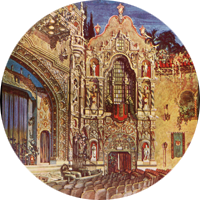
<< Go Back up to Atmospheric Theatres

The article “New Theatres for Old” was first published in the 30th December 1927 edition of Motion Picture News. It’s available online in various formats here  , from an original held by the Museum of Modern Art (MoMA) Library
, from an original held by the Museum of Modern Art (MoMA) Library  and digitized online in a joint project by the Internet Archive
and digitized online in a joint project by the Internet Archive  and the Media History Digital Library
and the Media History Digital Library  . The article is also available as a standalone PDF (15MB) here.
. The article is also available as a standalone PDF (15MB) here.
Illustrated with sketches from the author’s sketch book.
The rapid and altogether astonishing growth of the so-called Atmospheric Theatre, as a popular attraction as well as a distinctive architectural form, is responsible for many new developments of paramount interest to theatre owners. And the reflection of this situation is to be found here in this new presentation of recent examples manifesting advances which have been made under the expanding art of the originator of a new phase in the evolution of art allied with showmanship.
The pages which follow furnish reproductions in full color of the architectural and decorative features revealing the underlying principle as well as the method of execution of the idea embodied in the Atmospheric-style. Since color is a leading, if not the leading factor in the atmospheric effects it is only through a use of color in reproduction that an accurate conception of the style can be conveyed.
Comparison of these new examples of the Atmospheric Theatre with those presented in a previous issue, published June 12, 1926, emphasizes the many interesting advancements and refinements developed in an availing effort to extend the scope of original models and pictorial conceptions.
Equally interesting is such a comparison from the standpoint of its stimulation to thoughts of what the future may hold for the artist who has found in this style a medium richly endowed with opportunity for unfettered expression of imagination directed toward the development of new fancies and that most coveted showmanship ideal, Novelty.
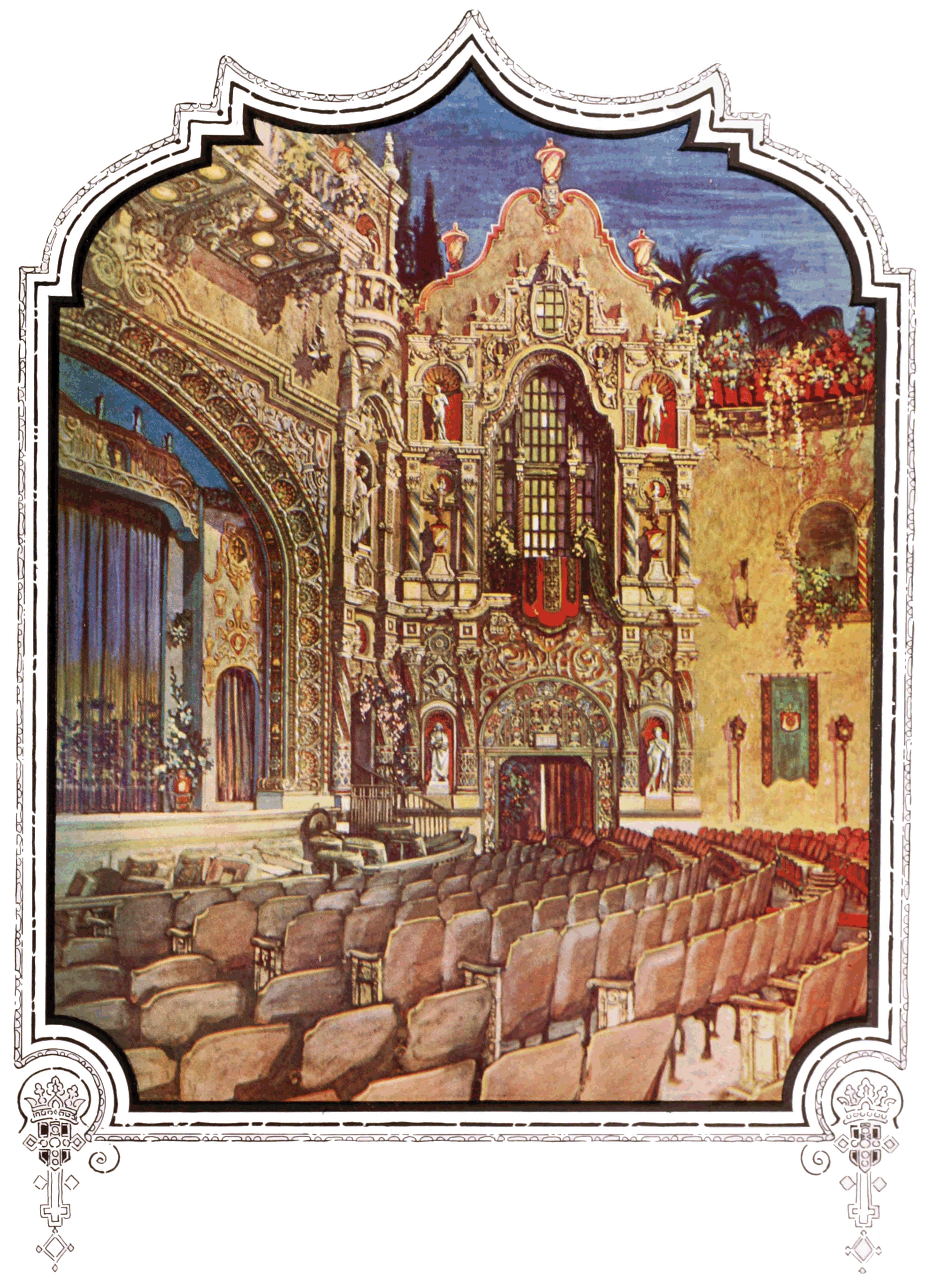
A Spanish Facade
A close-up study of the proscenium and organ loft of the Tampa Theatre, Tampa, Florida. A colorful interpretation with a touch of ecclesiastical feeling.
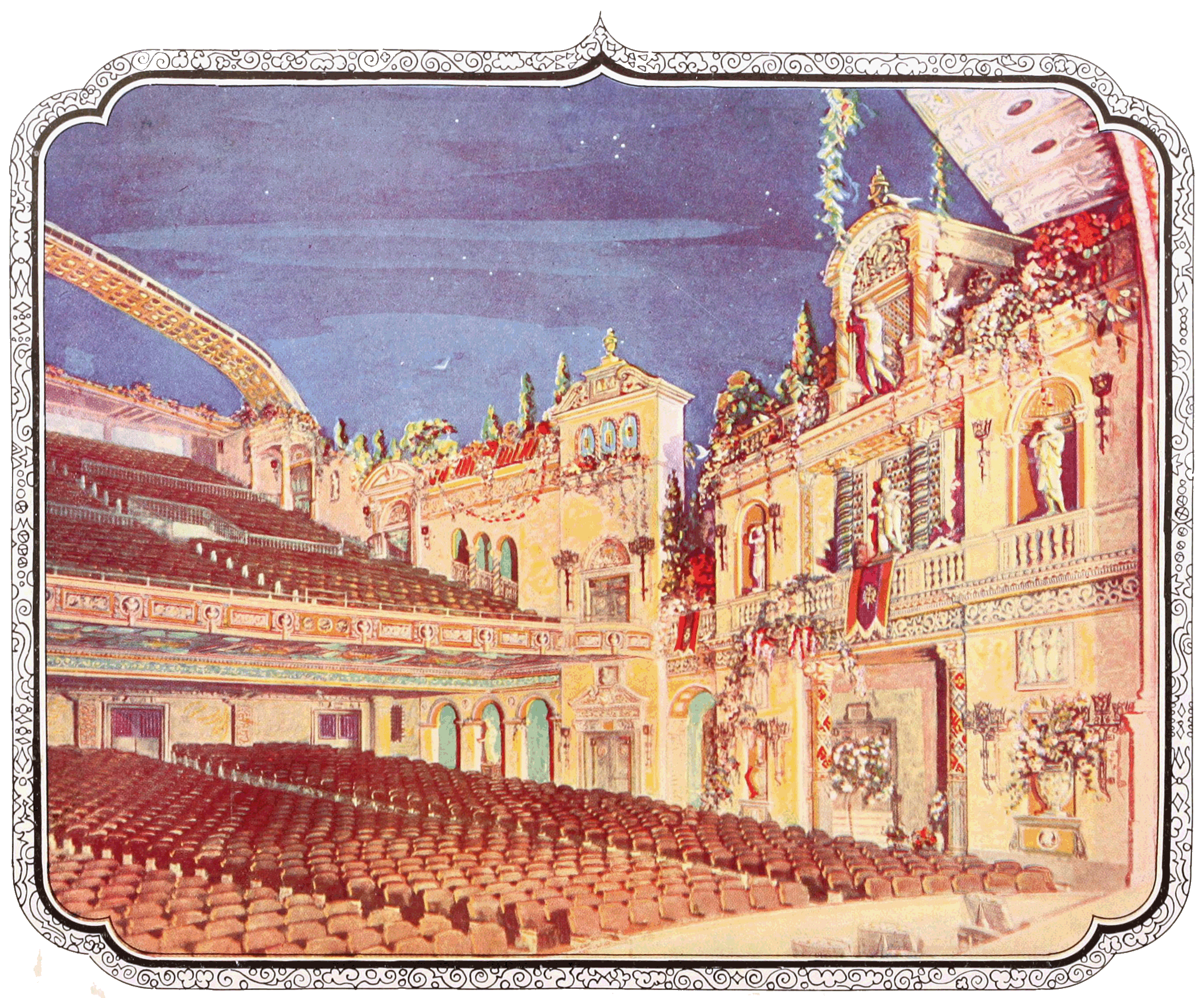
Italian Sidewall Colonnade
Sectional view of the auditorium of the Riviera Theatre, Omaha. Note the cold air nozzles in rear sky beam and orchestra floodlights under proscenium roof.
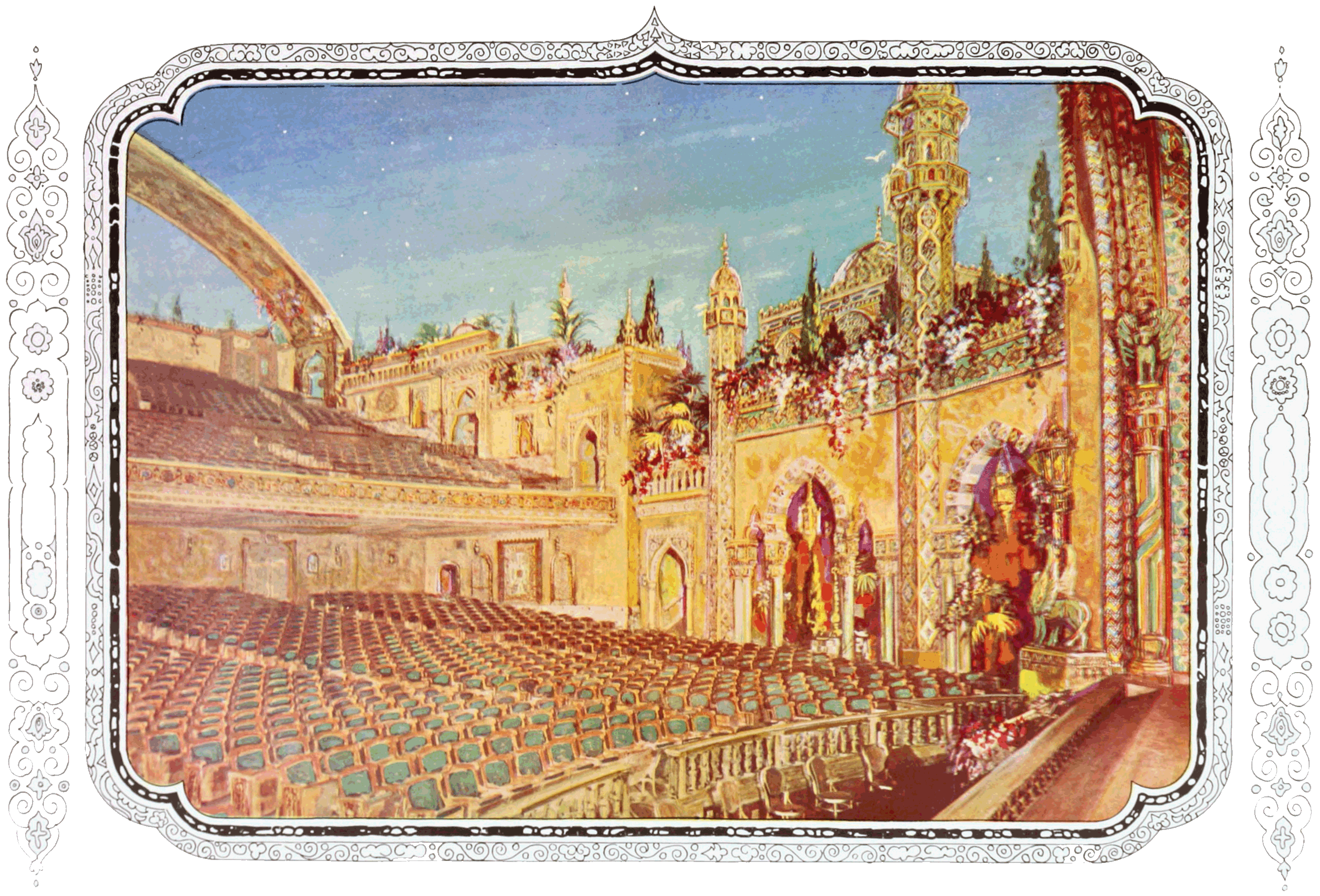
Persian Shrine Courtyard
The auditorium of the Avalon Theatre, Chicago. Of particular interest are the tropical tree and plant ornament executed in proper scale.

“Castles in the Air”
The Riviera Annex in Detroit. A one-floor picture theatre incorporating many interesting features. The castle with its garden in the foreground forms the projection room, and the balconies provides a specious promenade.
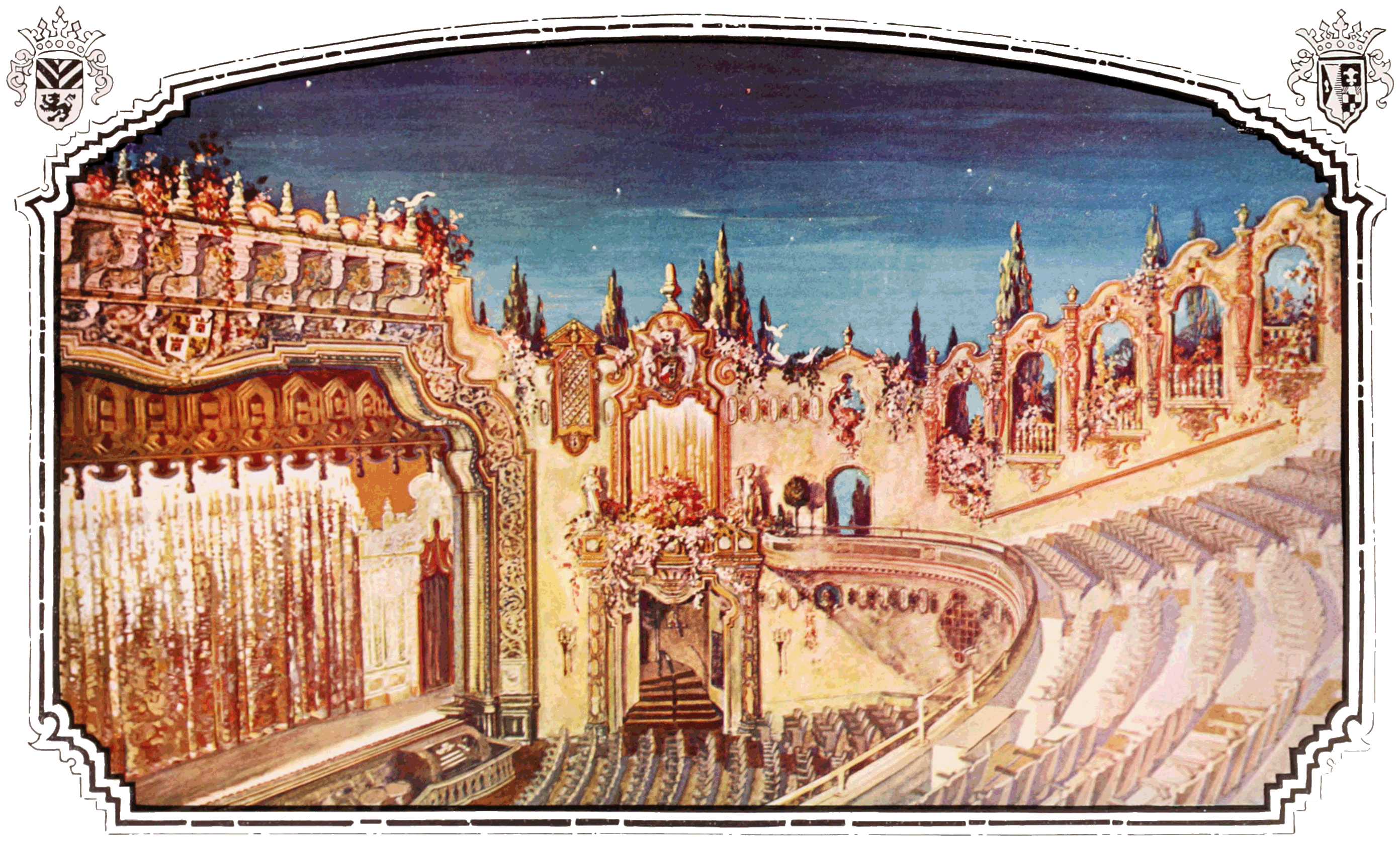
Spanish Churrigueresque
The auditorium of Young’s vaudeville theatre in Canton presents a faithful representation of a patio of old Spain. Cozy, intimate and cheerful in style.
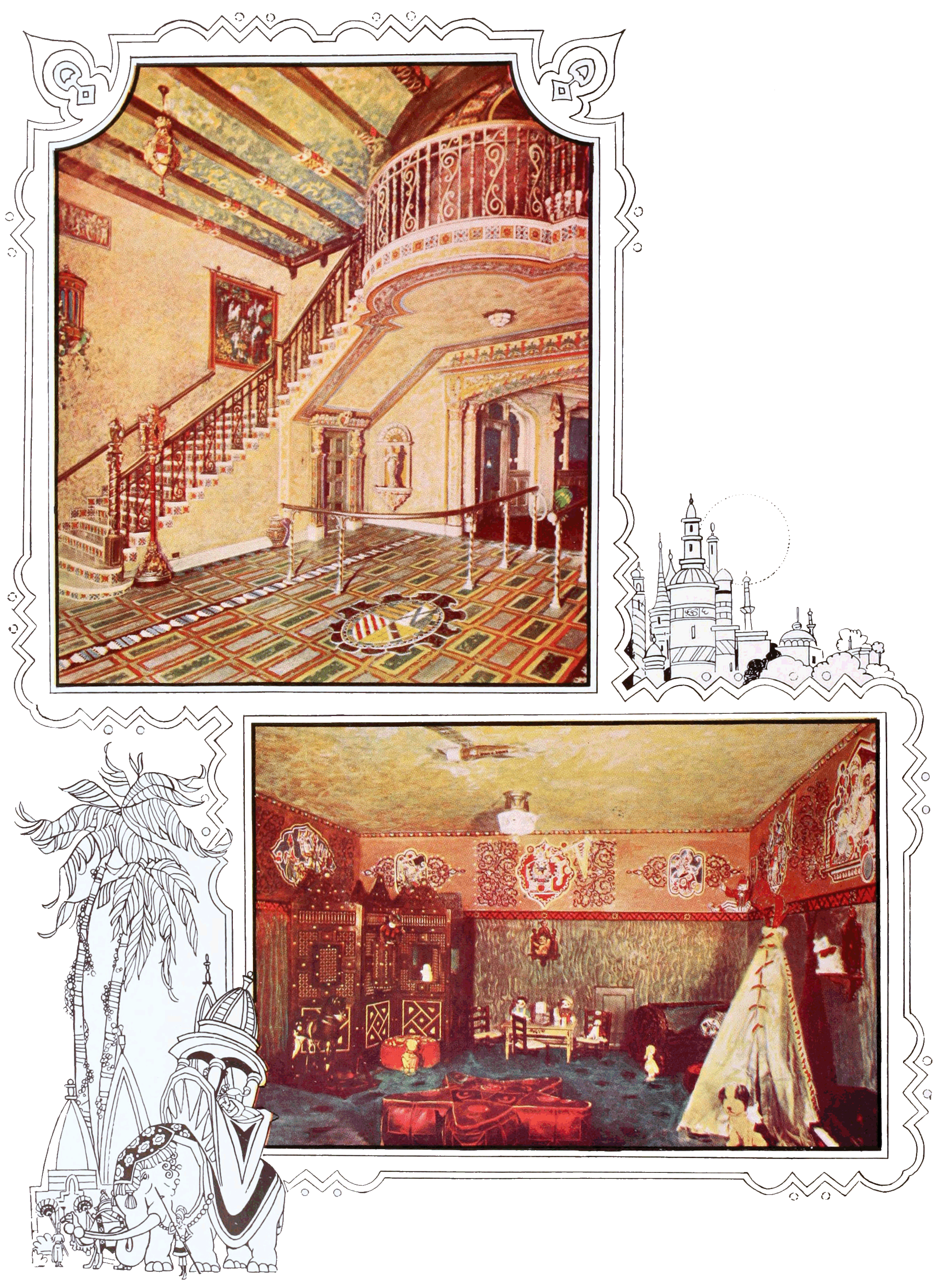
Lobby Stairway
Top: The inner lobby of Butterfield’s State Theatre in Kalamazoo. A bit of colorful, typical, clumsy and rude Spanish stairway with its tile risers and hand forged railing.
A Playroom
Bottom: The children’s room in the Avalon Theatre, Chicago, with its leather ottomans, frieze depicting Oriental fairy tales, and characters, is illustrated in the view above.
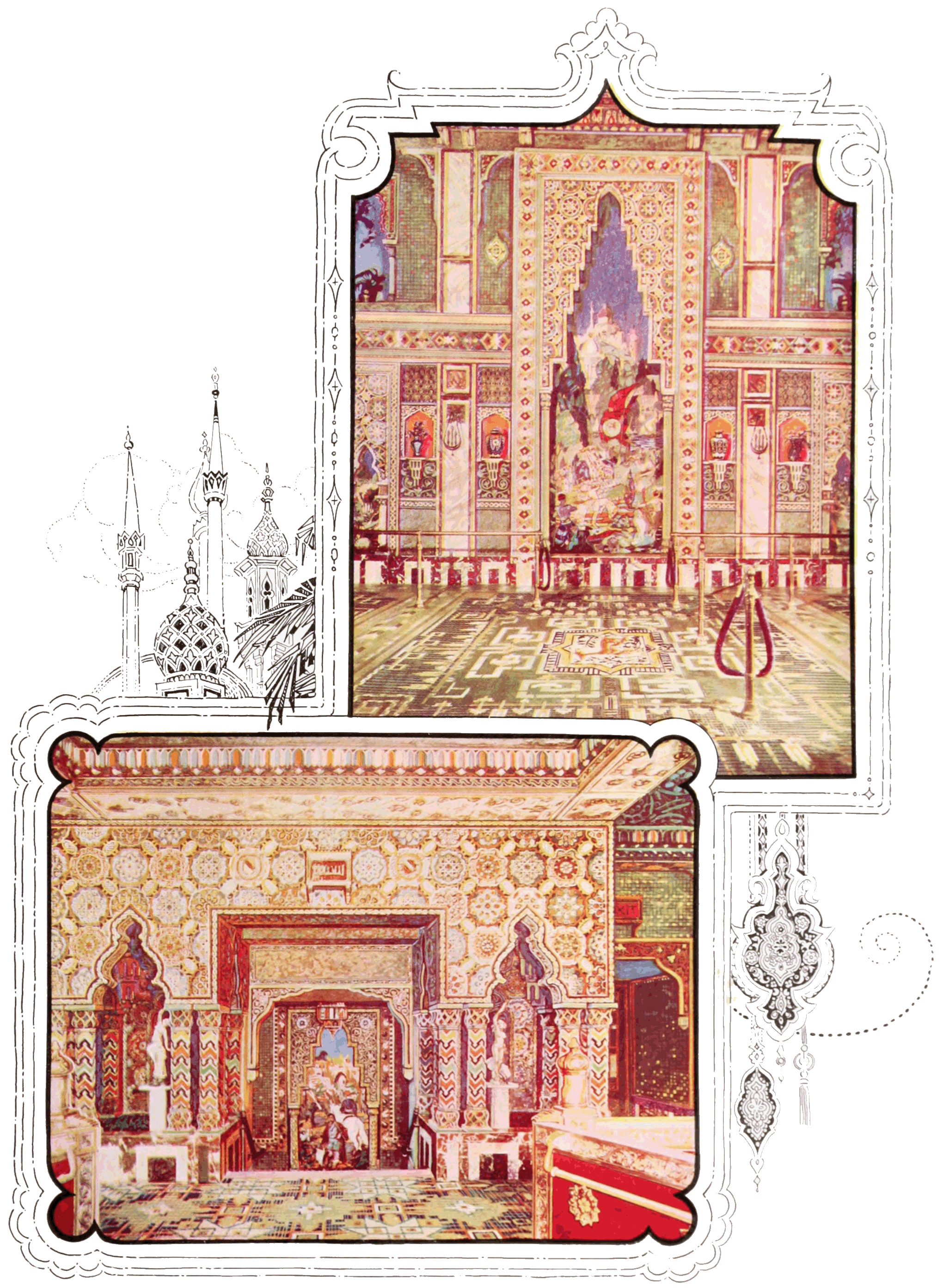
Avalon Mosaics
Top: At the top is shown one of the Charles Morgan pastel mosaics which are a distinguished feature of the Persian atmospheric theatre in Chicago. It is set in a Persian gateway.
Avalon Shrines
Bottom: A colorful feast for the eye are the shrines which frame the stairway entrance at the main level of the Avalon Theatre, Chicago. Carved ornament, interestingly textured and skillfully laid in myriad colors achieve a most pleasing kaleidoscopic effect.

Semi-Atmospheric
Top: Sidewall view of an auditorium executed in the semi-atmospheric style is show in the reproduction at top. It offers a new thought in design, providing rich opportunities for the painter and sculptor.
Proscenium Arch
Bottom: Graceful in design and richly colored is this arch treatment – well pierced to contribute to the impression of vastness and loftiness of the semi-atmospheric auditorium.
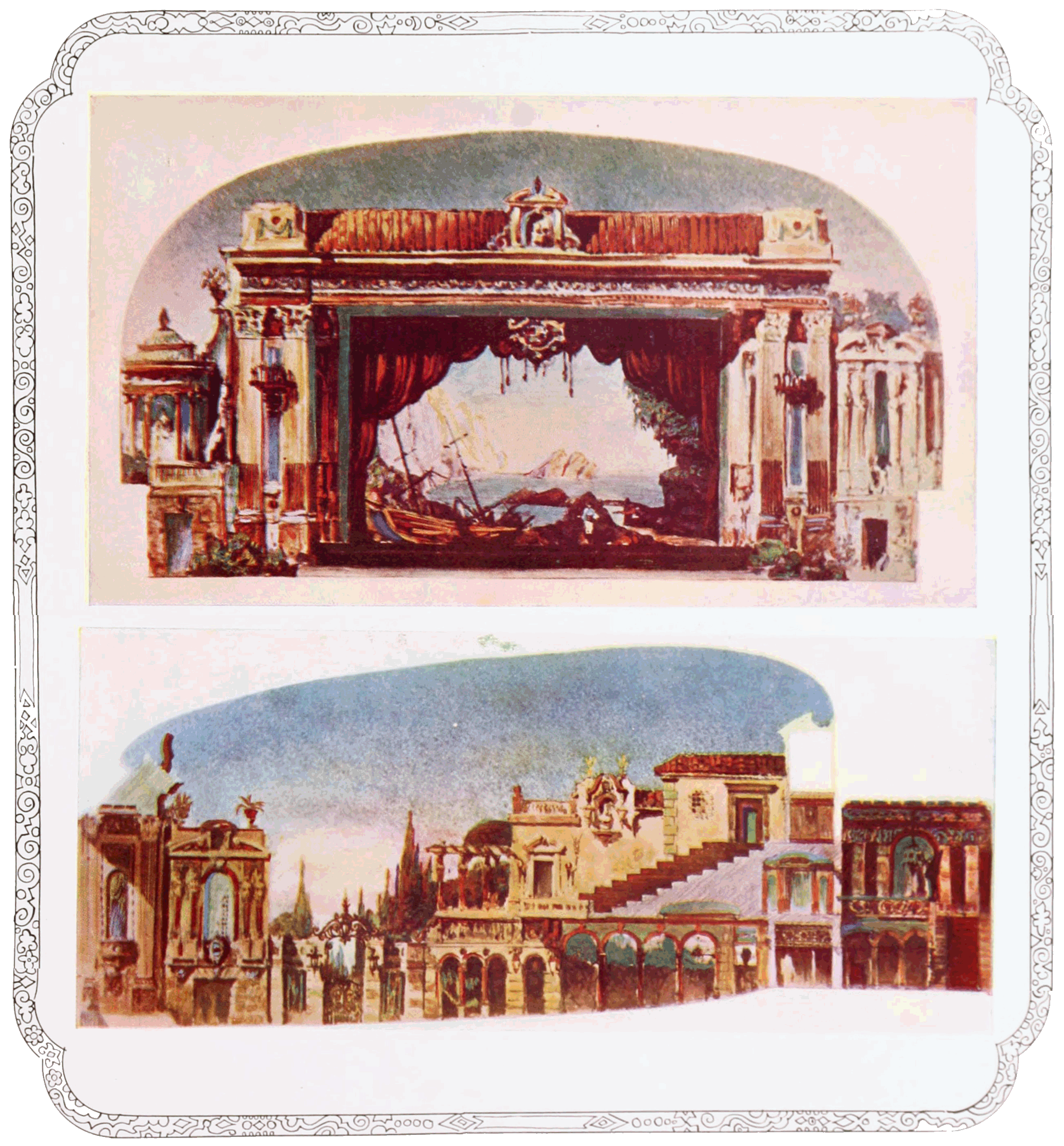
Italian Renaissance
Top: A classic form supplies the motive carried out in the proscenium arch illustrated above. The design is for a one-floor atmospheric theatre.
Classic Atmosphere
Bottom: In the auditorium illustrated above an appearance of extreme width is gained b the use of open garden gates. Note acoustically shaped dome ceiling.
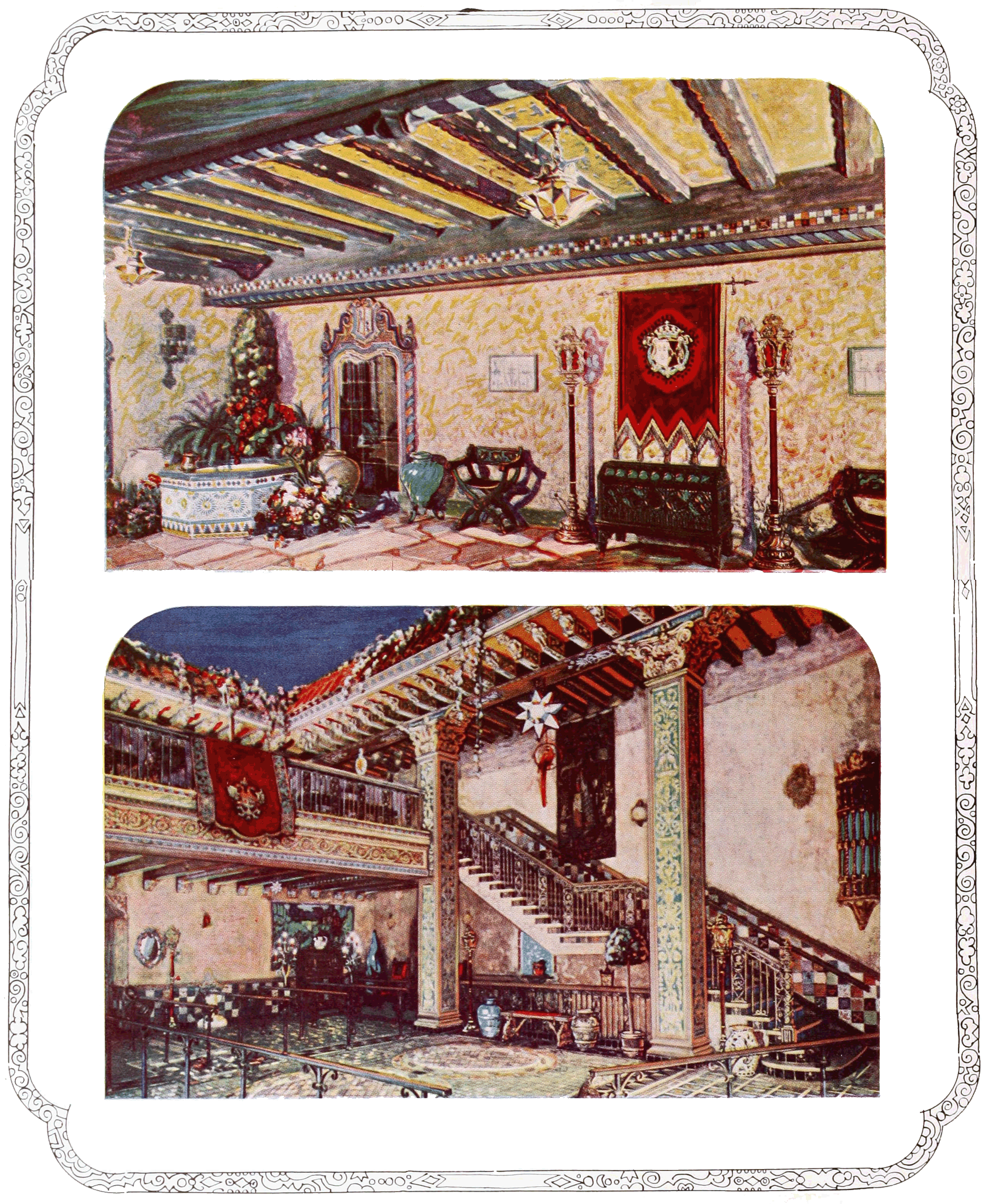
Rustic Spanish Courtyard
Top: Lower lobby of Loew’s Valencia, Baltimore, in which flagstones, wellheads, carved and polychromed beams create an interesting atmosphere. Used as waiting lobby for lift service.
Two-story Atmosphere Lobby
Bottom: One of the attractions of the Tampa Theatre, Tampa, Florida. Carved beams, rich rail banners and textured sidewall treatment are notable features.
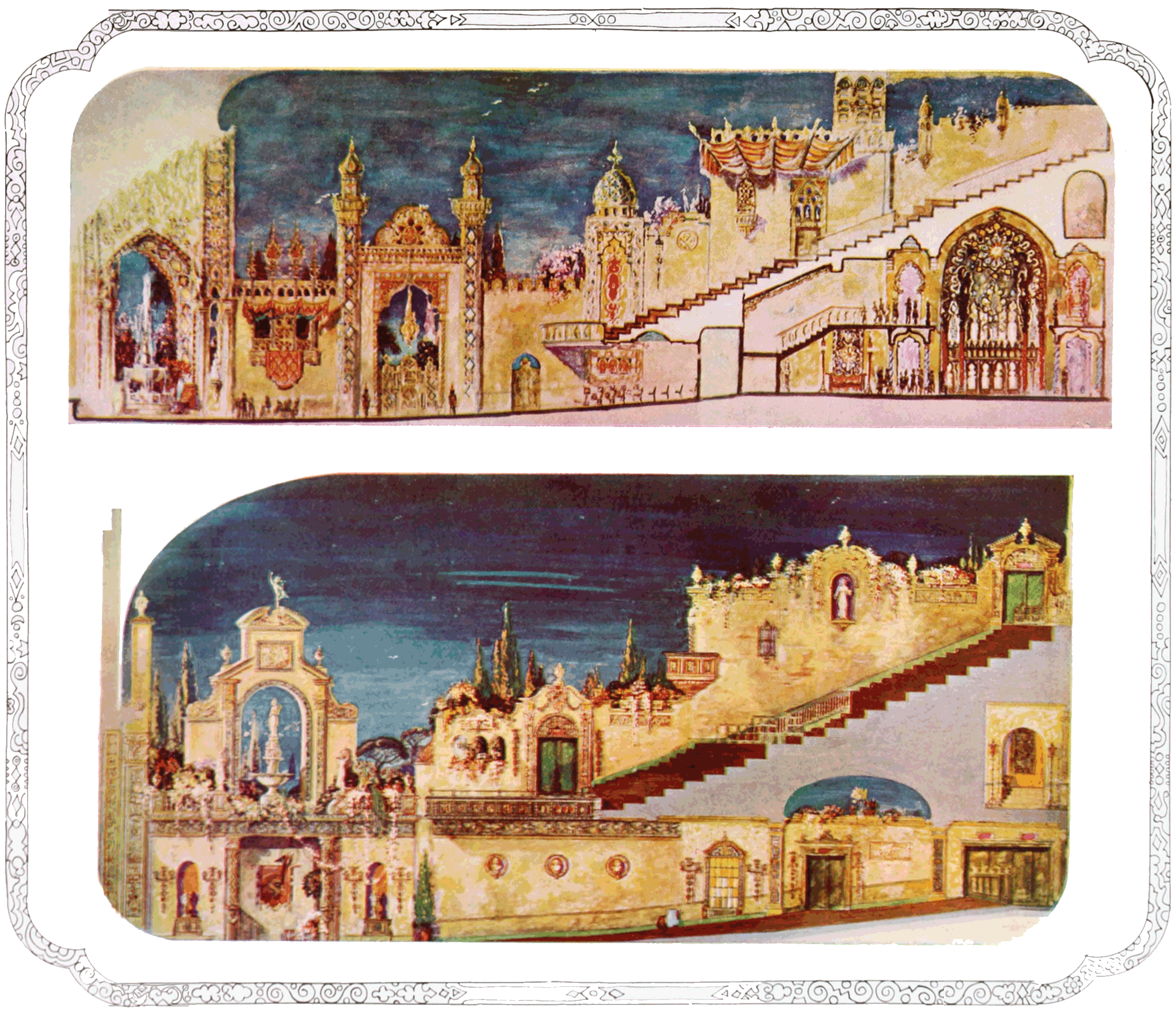
Warm and Friendly
Top: Sections through the Persian Theatre are shown in the top illustration. Features are the well pierced sidewall treatment and unique lobby with artificially lighted windows.
Sidewall Treatment
Bottom: Sectional view of the Universal Theatre in Brooklyn. An auditorium executed in a highly colorful style, elegantly finished with flora and interestingly lighted.
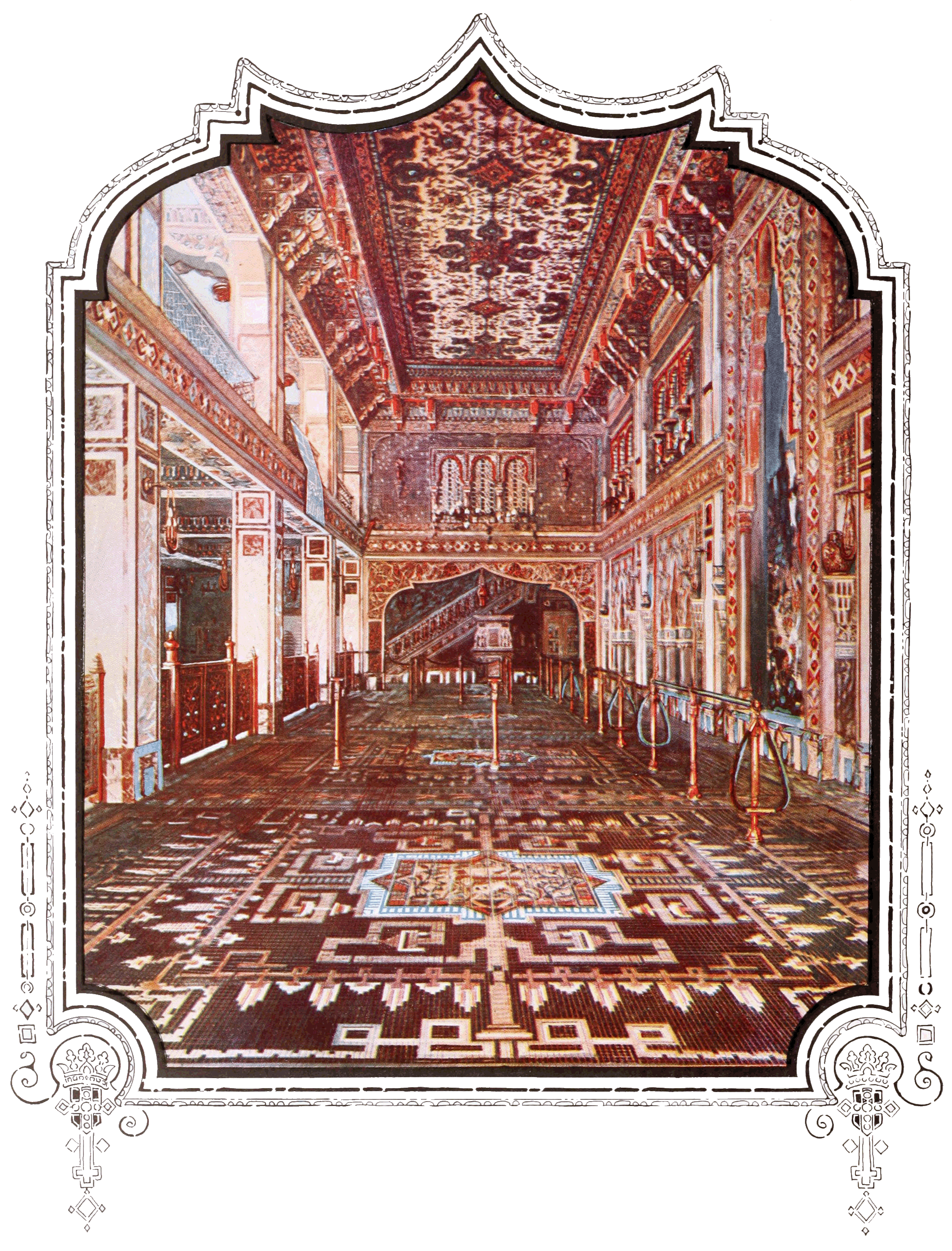
Recreating Persian Art
Lobby of the Avalon Theatre, Chicago. Noteworthy features are the jeweled Persian rug designed in ceiling, antique combination of faience and Ceramic tile floor, and multi-colored marble treatment of columns and wainscot.
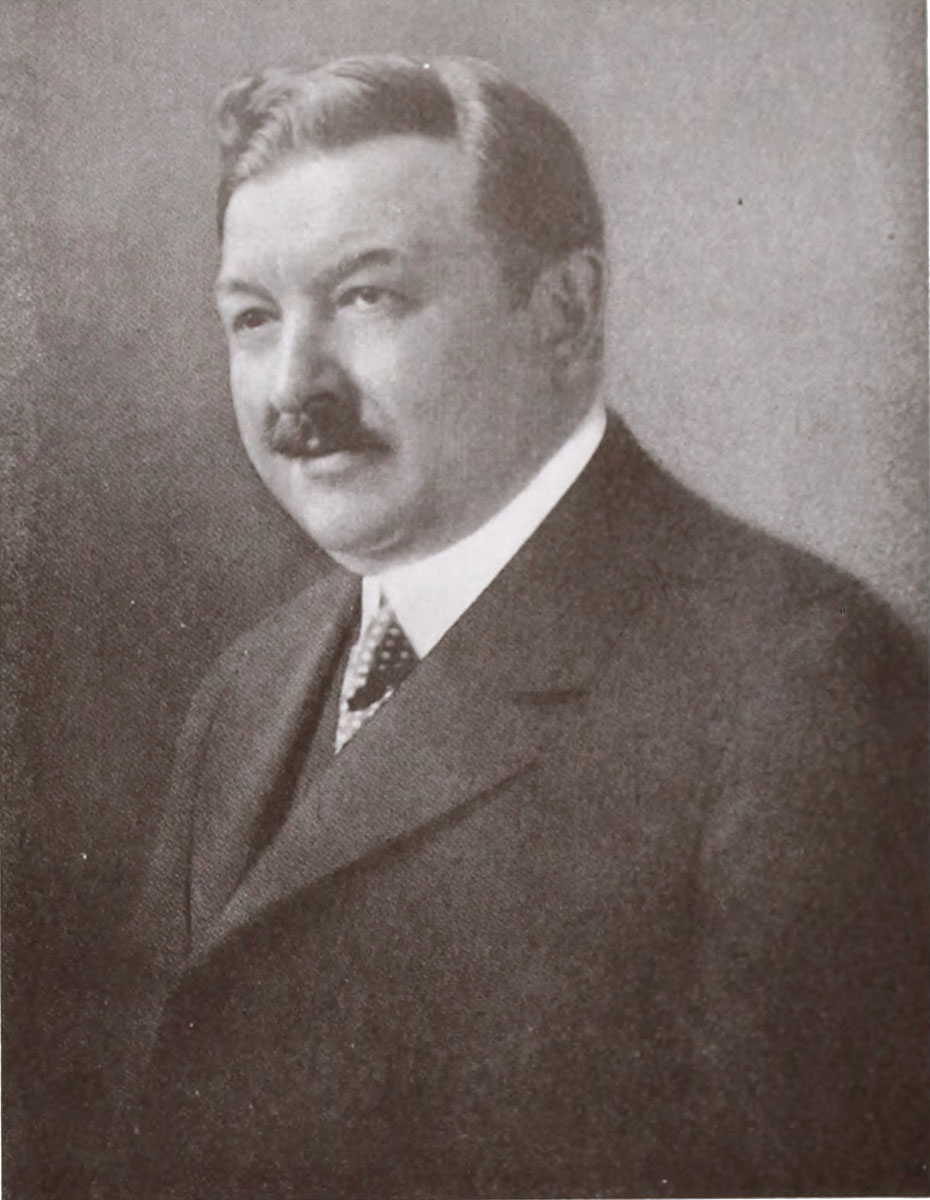
To give the “old” theatre new interest – to make the new theatre draw new crowds and attract a larger patronage! That idea – more briefly expressed in the headline, “new theatres for old” – is the crux of the problem facing. the theatre architect who is ambitious to take his rightful place in the scheme of modern showmanship
I believe that Wm. A. Johnston gave me the inspiration and the thought which prompted me to deviate from the typical formal theatres and thus lay the foundation for the original conception upon which the so-called Atmospheric Theatre has been developed.
I once read in one of Mr. Johnston’s editorials in MOTION PICTURE NEWS that it is a climax of showmanship to be able to make your audience feel at home, to make them feel that they have a most important role to play in the entertainment which they are attending, and that it is most necessary to create a warm and friendly atmosphere in the theatre.
To be a successful theatre architect, one must be a showman – of this I was convinced. So, struck by the idea expressed in that editorial, I turned my mind to analysing that thought and finally decided I knew just what Mr. Johnson meant by “warm” and “friendly”.
It was only natural, therefore, for me to direct my efforts towards and development of a different conception of atmosphere carried out in architectural treatment. A form and style that represented something new, but which imbued with character and individuality. In accordance with the specifications thus formulated, we designed our first “atmospheric” theatre – an Italian Garden. Then we went on and designed a Spanish Patio, and further we went and designed a Persian Courtyard.
The atmospheric theatre, I believe, has solved the problem stated in the headline to this discourse. And my belief rests upon an eminent authority – the actual records of theatres designed and built in accordance with the “atmospheric” principle.

Naturally it has been a great pleasure to me that there have been opportunities in which my own enthusiasm was shared by owners whose capital went behind some of my plans, resulting in the creating of several unusual theatre edifices executed in the Atmospheric style.
However, I do believe the benefits derived from the development of Atmospheric Theatre have been mutual. How true it is that “a man is only worth as much as he can do for others.” I pride myself that I was able to take the pulse of the amusement loving public, and I believe that I have written an architectural recipe which pleases the patron and gratifies the exhibitor.
The wonderful development of the motion picture industry during less than a decade brought about the creation of a great number of palatial theatrical edifices. These mainly have been copies, in a more or less faithful fashion, of historical buildings, opera houses or palatial houses in great metropolitan centers abroad.
Ambition and competition among owners and architects in these enterprises had resulted in the elaboration of ornamentation and architectural effort, until I felt the saturation point – if I may use the term in this connection – had been reached, and that an appreciative amusement loving public could expect no more development in this direction. Under such conditions it was not unnatural that the elaboration of ornament should go to extremes and in some outbursts of the competitive spirit result in many cases where the ornament became oppressive and overshadowed the stage and screen presentations.
Another condition of vital importance cost a rose in the wake of this trend. Huge investments involving sums sometimes far out of proportion to the potential earning power, are quickly reflected in the very policy of the theatre and create added problems for the showman, often resulting in top-heavy programs which in turn demand an increased admission. So that finally the theatre frequently finds itself wide of the mark as a resort for the masses and particularly that element of the mass which is admittedly the backbone of the motion picture following – “the family trade.”
Our first “atmospheric” design, the Majestic Theatre in Houston, Texas, has been the forerunner of over a hundred playhouses of t his type in a comparatively short period of time. This rather quickly-won popularity may be attributed to the fact that these auditoriums are successfully different and are merely dignified imitations of nature glorifying classic architecture. Few innovations in the theatrical business have taken root as quickly as t he Atmospheric Theatre.
There is a general reason for this not only a specific one. The modern tendency in theatre construction covering the cinema field as well as that of the opera and vaudeville field, is to break up stock theatrical conventions and to introduce variety in the theatre building as well as in its program. It provides indoor entertainment with a correct outdoor setting.
We find it more difficult to design and execute a genuine “atmospheric” theatre than what we term a “formal” theatre. The necessary amount of detail work and study to create a consistent atmospheric theatre is endless. It is true we are glorifying classic architecture, and are copying Mediterranean art in color, sculpture and form, but to make the illusion perfect requires not only a thorough understanding and knowledge of old world architecture, but we must also know how to transform and create these antique soft textured and interestingly polychromed buildings with modern tools and artcraft.
Unfortunately, misinterpretations of the idea behind the “atmospheric” theatre, have appeared in different sections of the country; on the other hand I saw some very beautiful examples of the atmospheric theatre designed by reputable architects, most cleverly executed and pleasingly decorated.
It must be very apparent to all those who have seen some of our genuine “atmospheric” theatres, that the real success of these auditoriums lies in the fact that we have spared no effort to be consistent in the execution of our work, and we have given all details both as to shape and color, the minutest attention and study.
To be really successful, and not just an imitator copying the work of others, we must historically, graphically and architecturally study the periods and old world localities which are furnishing the theme for our outdoor garden auditoriums.
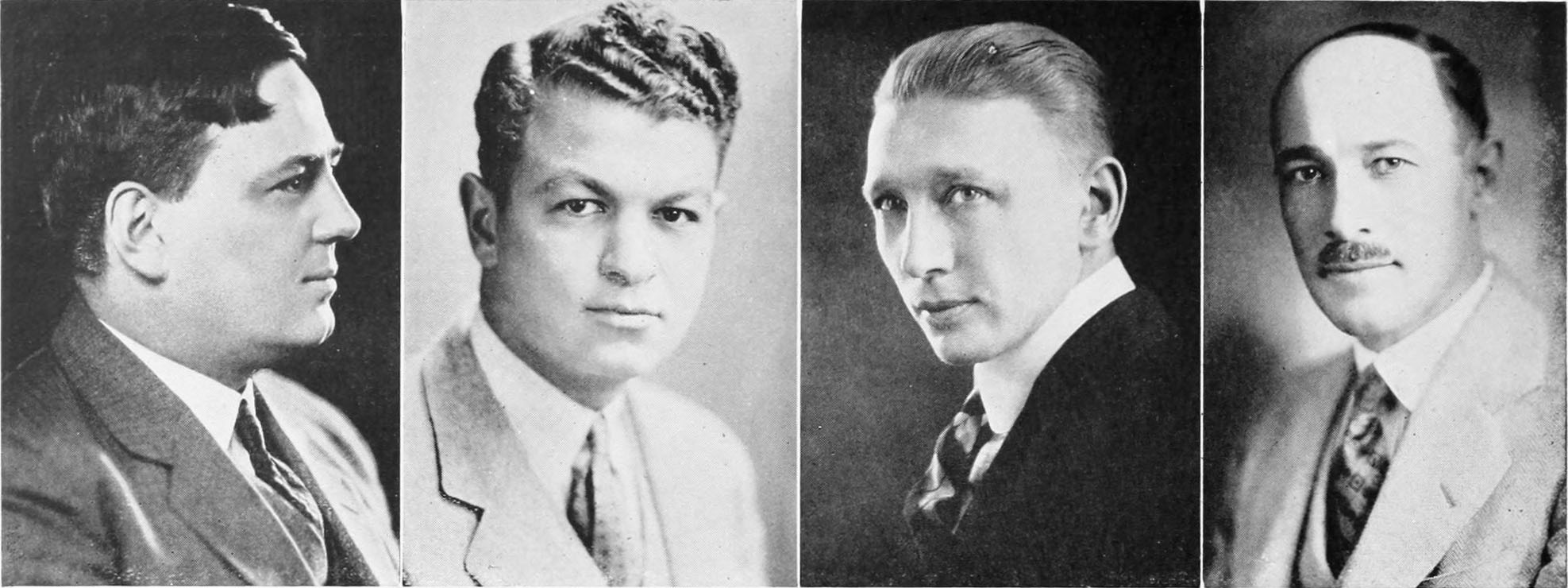
If our theatres are interesting and impressive it is because the very nature of the pastel coloring executed in hundreds of desired shades and colors, lends itself so well to the imagination of the average person, and as we linger and look about, our fancy is free to conjure endless tales of romance.
And thus, we are called “Colorists”. And that is the reason we believe that our own creations of the “atmospheric” theatre have been so successful. By the “we” I mean my trained associates and friends of many years standing, such as A.C. Liska, A.O. Budina, Raymond Mork, A. Mercil , B.H. Armiger, and my son, Drew – we all work together.
Our designers and decorators are taught the art of appealing to the imagination of the public, and whenever you leave something to your imagination, you automatically and instantaneously create interest. Thus we furnish plans and designs, color schemes and plans for furnishings, all with the object point to appeal to the imagination of our patrons
Our latest and most successful theatre is the new Avalon Theatre in Chicago. Chicago moviegoers are already inured to delights and luxuries in the temples in which they consume their cinemas, and it was a real problem to create in the City of Chicago, a playhouse which would be outstanding, but we believe we have succeeded.
I believe that in the new Avalon Theatre my boys have helped me to create the finest Oriental room ever built. The lighting effects especially are unusual. We often talk about the moonlit sky of the Mediterranean but at the Avalon our lighting effects have been designed to give us a sweet twilight effect. The two sides of the auditorium are unsymmetrically treated, showing in true architectural design the jeweled minarets of the Persian sacred shrine and temple towering towards heaven amid drooping palms and majestic shrubbery.
The ante-rooms and lobbies of the Avalon are brilliantly lighted and luxuriously furnished in genuine Persian furniture, specially imported from the Orient. Blue and yellow are the predominating colors and the Persian motif has been carried out to the most minute detail, achieving elaborate effects without the banal result of gaudiness.

Outstanding among the decorative features of the Avalon Theatre are the original mosiacs [sic] executed by Charles Morgan. As individual attraction a well as harmonizing element importantly contributing to the atmospheric scheme of the Oriental architecture and decoration, these works of a rare and exquisite art deserve high rank among contemporary productions.
We conceive the scene, and the artist makes his own materials and portrays in his own way the murals which accent and at the same time enhance the “theatre picture”.
Using a secret process, he makes his own materials in the form of small thin stone pellets. These at [sic] broken into small shapes and then cemented on surfaces to create the pastel mosaics. To me these mosaics represent the finest art of painting with broken stone. The charm of ante-rooms and foyers of the Avalon must in all respects be entirely credited to the unusual work of Charles Morgan, who found in this atmosphere the opportunity to excel in his art.
Being thoroughly familiar with Mr. Morgan’s efforts in this line, I thought that the pastel mosiacs [sic] would lend themselves most effectively to the color treatment and the embellishment of an Oriental room I had in mind for the Avalon Theatre. When you visit this wonderful place I am sure that in viewing these mosiacs [sic] you will gain an impression of having really visited the mysterious East. There we were opportuned to picture Persia, – Persia, the rose-colored country of the Eastern hemisphere, – the land of sunshine and cobalt skies, and to us this western world is a land of enchantment and “Dreams come true.”
In another sketch you see the street and market places busy at dawn like menageries with huge elephants bedecked with the luxurious red velvet cushioned houdahs and their gorgeous gold bejeweled embroidered trappings. See how With their trunks swung low they amble with slow magnificence through the crowd of dancers and musicians. And the giraffe with heads held high following close upon the heels of this less stately friend. The camel, the principal beast of burden of this land of sunshine is usually ragged but supercilious, glaring at all like our old women The saris of the women, the turbans and waistbands of the men, the flouting veils of our street dancers, vermillion, magenta, orange, green, purple and turquoise, a veritable rainbow of opalescence, – the necklace, dozens of bracelets and anklet of the dancer catch the sunlight like myraids [sic] of tiny mirrors, – these mosaics recessed and encased in Persian tracery, the skilful [sic] work of specially trained modelers artistically and colorfully polychromed in myriads of hues of color by the hand of artists which I had the pleasure to meet and train in works of my liking.
Behold the quietness and shade of this small pool where the numerous birds of brilliant plumage fly for refuge from the midday sun to plunge unmolested in the cool clear water. Behold the water carriers pause for a short siesta in the heat of the day to gaze in the pool and dream perhaps of more mysterious moonlight. The beholding of such scenes inspired the work which lead to the creation of the sweet and mysterious interior of our Avalon Theatre.
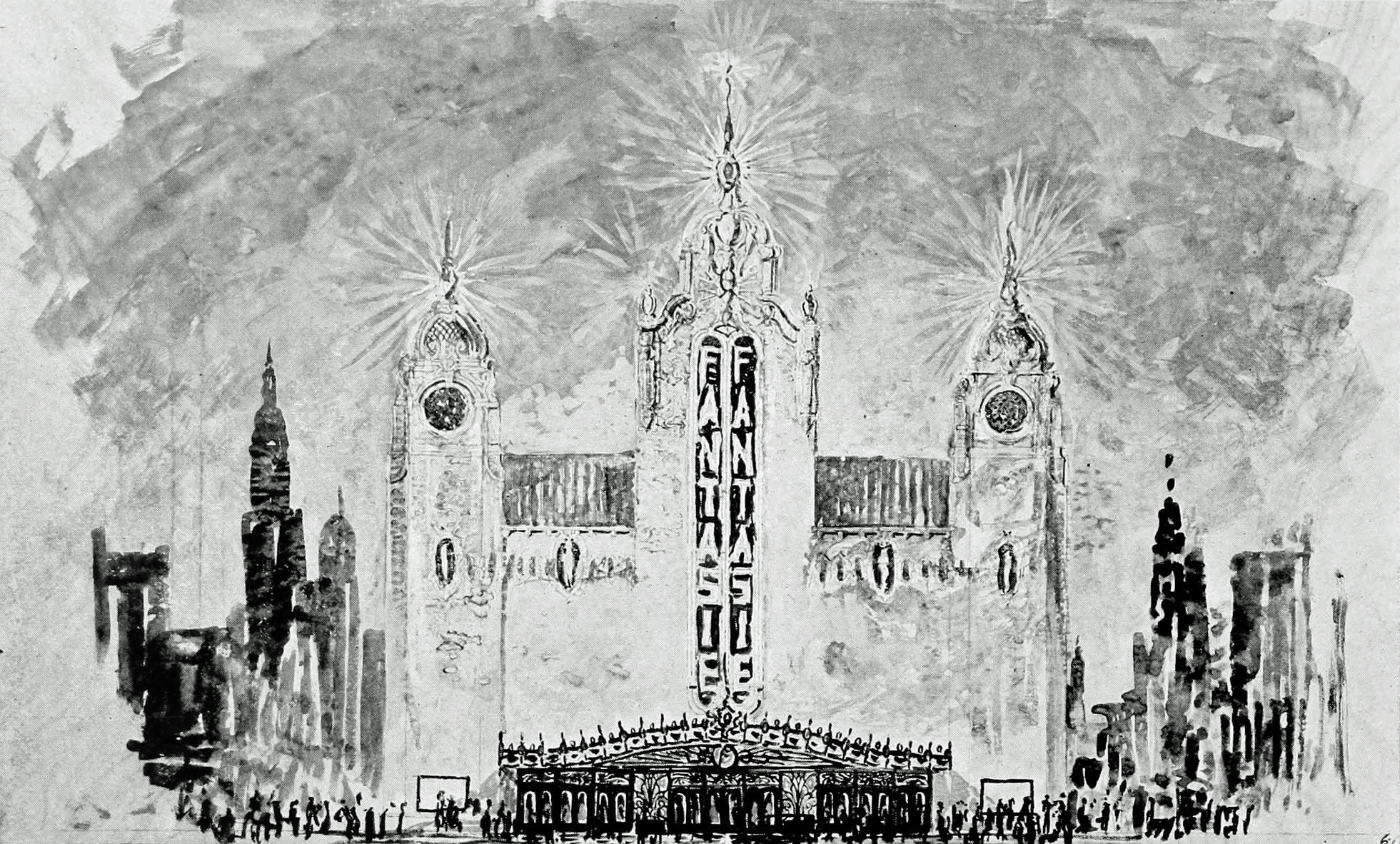
Consider still another note the strong young slave has no time for siesta, his master commands the fruit and vegetables shall be taken to the busy market place, and what slave dare disobey his master! Here, the market place! – how quaint and old worldlsh it sounds to us of the skyscraper cities, but Persia, that is different. Persia at the Avalon Theatre is different! It is there that the royal nabobs and lords gather to barter and exchange everything from fruit to human souls. The musicians beating on the tom-toms, – (you see one of these tom-toms in one of the niches in the men’s smoking room) and strumming the stringed guitar-like instrument, and the dancers keeping up their almost continuous twisting and training with hands outstretched for a coin from all who pass, compel us to pause for a longer view.
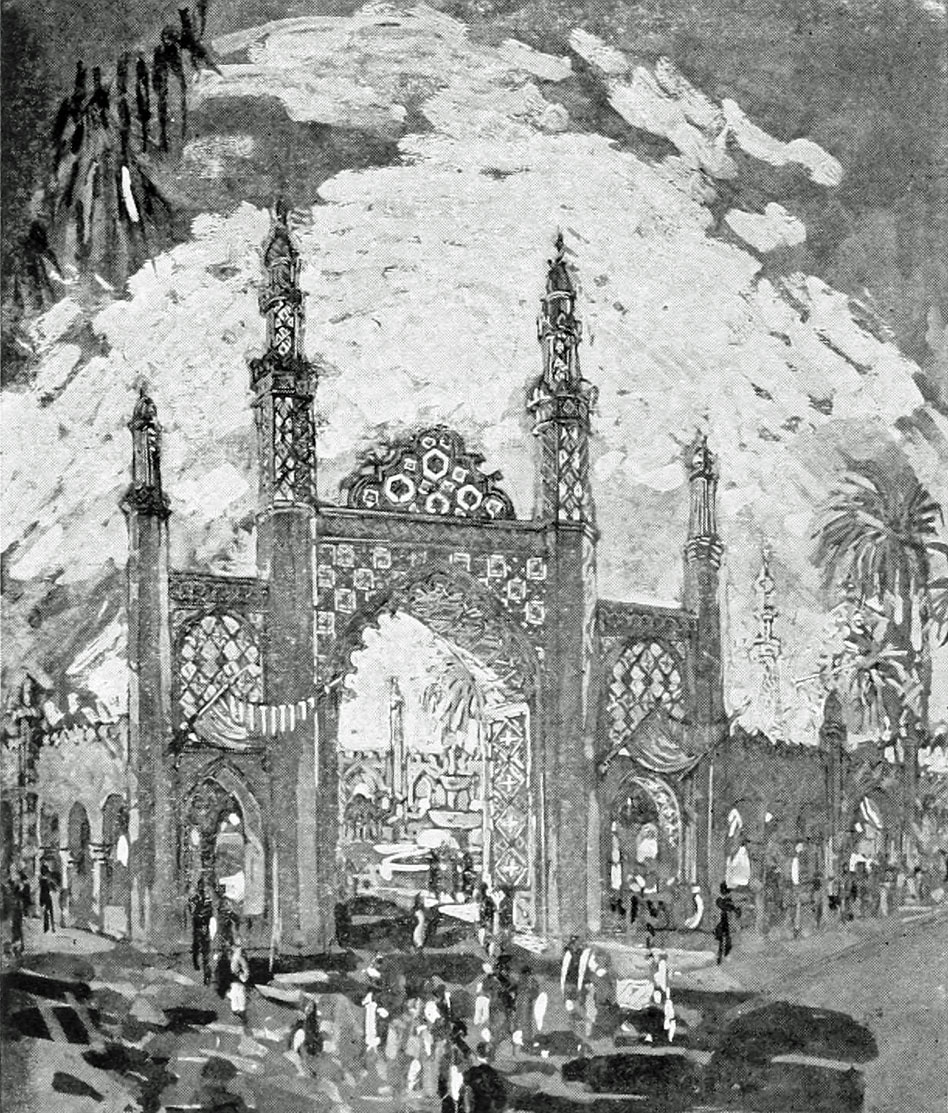
While it might not be possible for either Charles Morgan or myself to stand there in the lobby and preach the Oriental mysteries of these mosaics and their subjects, I fully believe that the character of their execution, – their surroundings, the lighting, and the consistency of it all, have a wonderful influence and wonderful understanding of what we were driving at in almost all and everybody who enters the Avalon Theatre.
The large mosaic which you see here in the center indicates in the distance those signs of Oriental worship, – the mosques, minarets and towers, some of which we have reproduced in actual relief in the auditorium. The rose colored buildings decorated with elaborate filagree and painted with patterns of floral design. The pyramidal temples and glistening domes against the colorful sky, dazzle us. In little cubicles the master craftsmen follow their trades in full view and almost on the sidewalks; the enamelers; the dyers of silk and cotton; the brass workers, each a colony in itself. There is more in these mosaics and sketches than you see at the first glance.
We are charmed and intoxicated with the color of it all, – its brilliancy follows us everywhere. How well our interior decorators have caught on to the spirit of these mosaics and how faithfully they have worked in the execution of the tinting and laying-in with color of ornament and texture of walls and ceilings in these beautiful Oriental rooms!
It is the inspiration, companionship and good friendship of such a man as Charles Morgan that give us the vision to create perfect illusions with brush, paint and electric ray.
Another remarkable work of handicraft is the wall texturing in the foyer. There is a stretch of hand-scratched plaster exactly reproducing the work of Persian masons.
The entire ceiling treatment as far as ornament is concerned, resolves itself into a special finish smooth surface, eliminating complicated furring, framing and ornamental plaster.
The proper furnishings for an “atmospheric” theatre can be found in the market where true antiques and correct reproductions are sold, at prices much below the gaudy and elaborate furnishings and bric-a-brac required by a formal theatre.
The construction of the garden walls and the reproduction of exterior facades in the theatre auditorium, permit the locating of ventilating ducts and other mechanical apparatus, to good advantage, resulting in lower costs.
While talking about ventilation and atmospheric conditioning, I want to call your attention to the principle of direct fuel to air, delivering properly balanced, warm treated air with ventilating. This in itself represents a most economical method which can be advantageously installed in the “atmospheric” theatre. The flexible method of air treatment in conjunction with the architectural setting of the “atmospheric” theatre has much in giving continuity to producing that comfortable “warm” and “friendly” feeling.

The warmth is obtained by mean of direct fuel to air systems conducting the heat directly and quickly to the volume of cold fresh air necessary to properly ventilate the “atmospheric” theatre without any intermediate or usual heat losses. This air is drawn in through the fresh air shaft into the fan room passing through the air washers being thoroughly washed and properly dehumidified. From this point it is properly and scientifically distributed to the portions of the building to be heated and ventilated. The principal feature of the system direct fuel to air is its flexibility, economy of installation, simplicity of operation and maintenance
Compare the necessary up-keep and the proper representation of a smooth, highly polished minutely detailed surface with that required by correct representation of an antiqued interior, antiqued wall surfaces, rustic fixtures and dull finished ornamental metal work, and there alone a great saving in the operation of a theatre can be accomplished without in the least detracting from its appearance.
We have come in contact with the Construction Departments of several of our large theatre circuits, and we are grateful indeed of having met men who have acquired through actual observation and practice and in the course of gigantic theatre operations of their respective circuits, knowledge, which translated into architectural form, is of untold importance and interest.
We believe that through the intense activities of our large theatre circuits, and by the enterprise of independent individuals, large moving picture theatres have been built in great number, well meeting the demand, thus considerably curtailing the anticipated building activities as far as super-movie theatres are concerned in large Metropolitan centers.
However there comes a great demand for small theatres in small towns, and we have developers several plans for atmospheric theatres which can be interestingly built in small communities at a cost in keeping with the practical and financial set-ups visualized by the exhibitors.
We also have given the question of remodeling considerable thought, having devoted a special department in our organization to the remodeling and rejuvenating of old theatres.
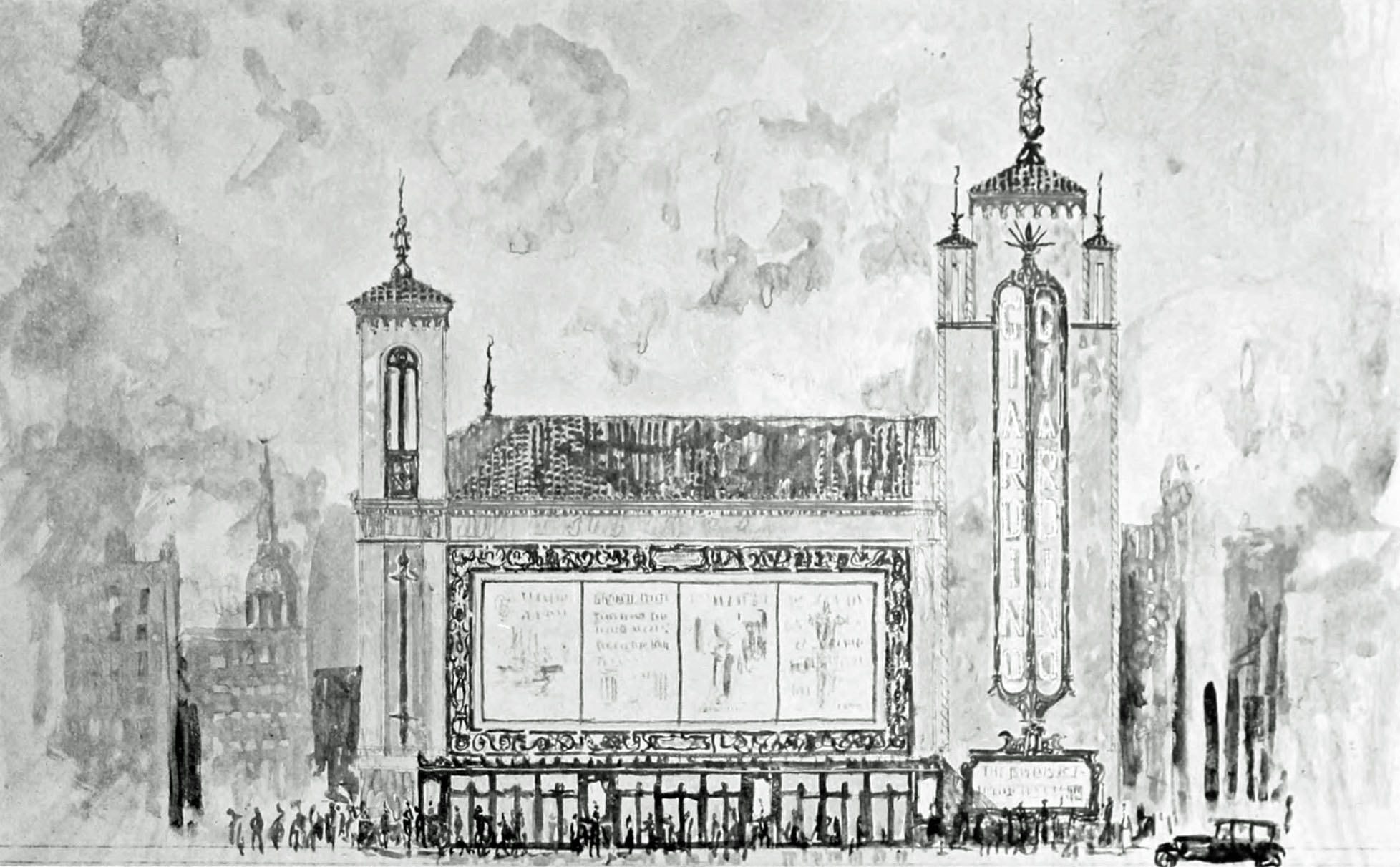
I am not so carried away by enthusiasm for my work as to insist that proper architecture or proper decorating is all you need to have a successful theatre, but I do believe that an architect can be very, very helpful to an exhibitor in creating success and in pleasing the public. The show after all is the principal thing in the business – a good show I mean. The best and finest theatres – the most artistic theatres, and the most costly theatres cannot succeed without a good show.
And here I believe is the most important thing that I would like to impress – cost.
I want to create theatres where pictures can be enjoyed in restful and beautiful surroundings rather than one that would be a mere flaunt of lavishness. I want my theatres to create the feeling that one wants to come back and enjoy the restfulness of its surroundings. I don’t want my theatres, lobbies and ornament to look at you and say “Look what I cost”.
It has been proved by the successful conclusion of many building operations in different sections of the country, that an “atmospheric” theatre on the same ground and with the same seating capacity, can be built for less money than a formal theatre, and the reason for this lies not only in the fact that the general character of material required to create these outdoor illusions is of different character – we use less marble – less bronze – less hangings – than a formal theatre.
We strive to use more art and less tedious methods of decorating to get our effects. Our appropriation for lighting fixtures which are usually either imported originals or true copies of foreign characteristic work, is smaller than required for palatial formal interiors.
Defying and dodging if you please so-called “Professional Ethics,” and desirous of injecting myself into the actual execution of sculpture and decorative painting, I have been prompted to eliminate competitive commercialism from the finishing trades in the pursuance of my profession. But I feel that my conduct in this respect and the services rendered, have been eminently satisfactory to my clients.
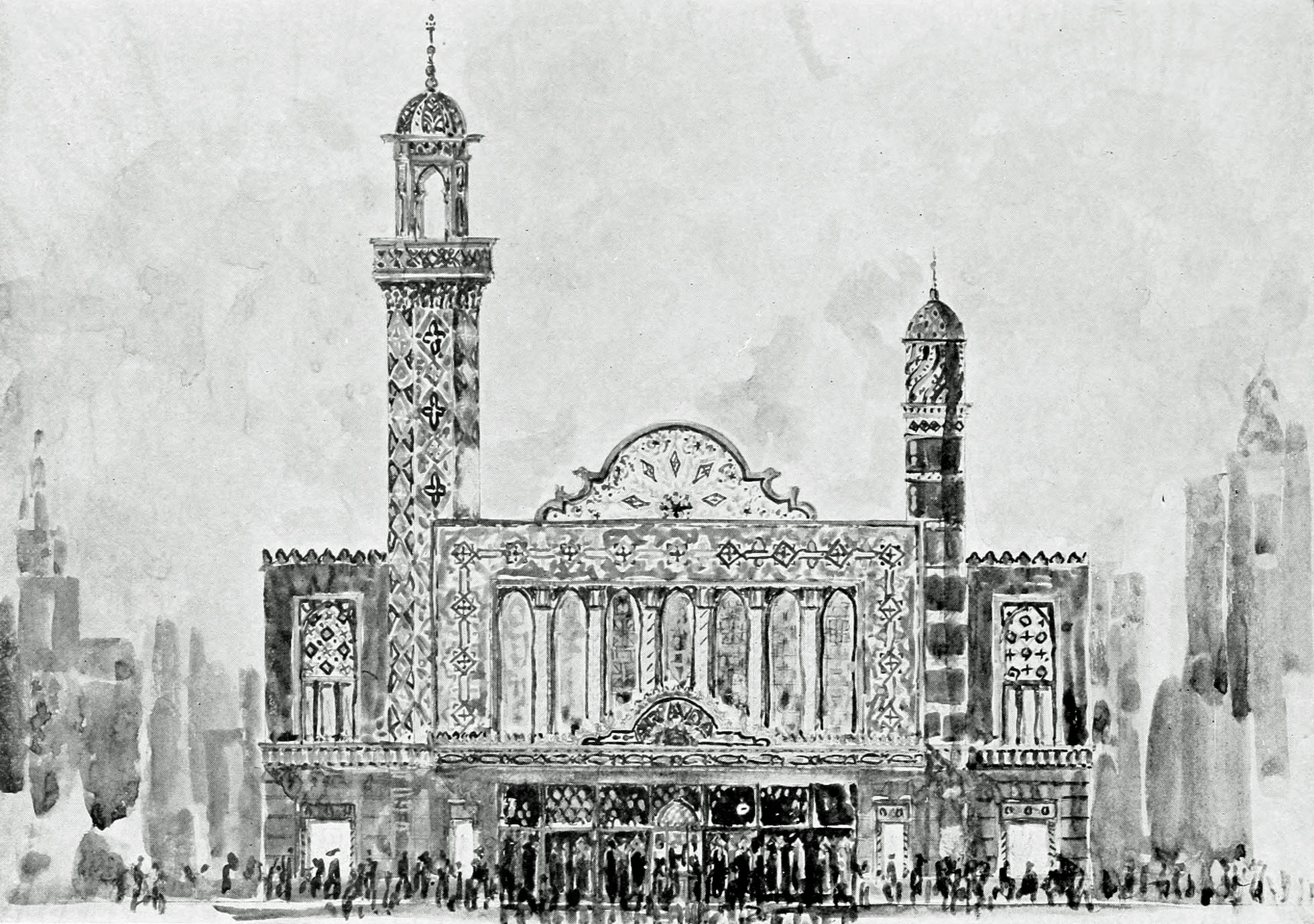
If people like the work we are doing and want the results we can obtain for them, I must be allowed “To use my own tools,” so to speak. Our plan is to work on a fixed appropriation covering the ornamental plaster and decorative work, and we like to have owners entrust to us without any handicap, the execution of this work with the aid of such men as we know are familiar with our ideas and dreams, and possess that very necessary understanding and skill of sculpture and paint requisite for our effect and finishes.
Sculpture and paint in our case must go hand in hand, because you will note the decorations such as carving and sculpture in collected masses must be executed in color, reflecting the customs of the artist during the period and times which we are reviving. I am talking about the art of fresco paintings and the application of color on the outside of buildings.
I like, as I said before – “To use my own tools,” in the creation of our “atmospheric” theatres. Did you ever notice the peculiar blue we are using in our “atmospheric” theatres? It releases the nerve tension of the audience; refreshes the eye; makes one feel that one can breathe, and it has one hundred and one beneficial effects on the mind and nerves.
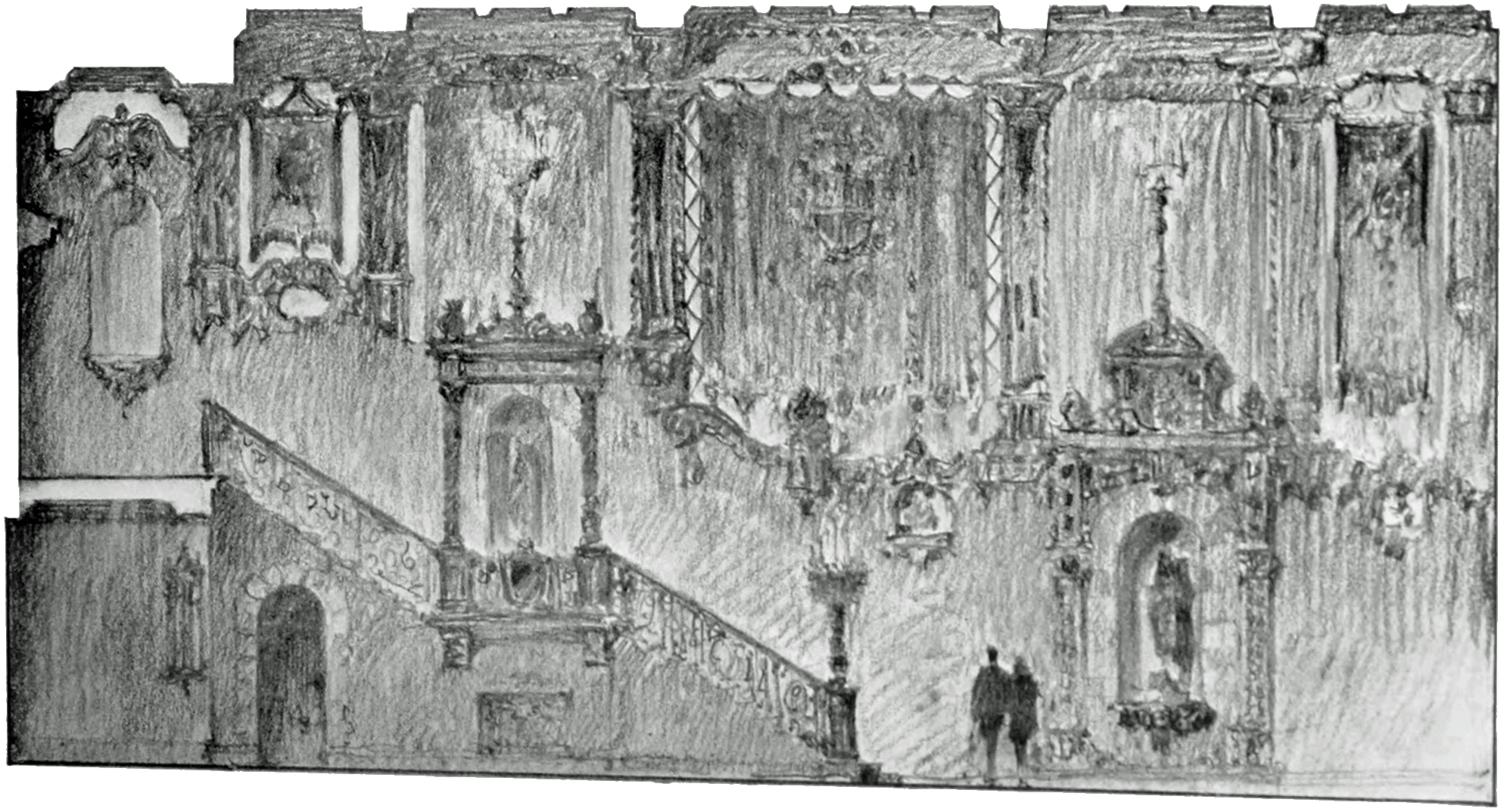
A Pergola scheme effectively used for an Entrance Lobby
Blue is always described as the color of Hope. This not a fanciful and trivial sentiment, but a fact which can be scientifically proved, but it must be a certain, defined and distinct blue on a certain defined and distinct textured surface. We know how to do this, but cannot write specifications to cover the execution of this “Color Health Recipe.”
And what is true of my principal color schemes is also true of my relief colors and high-lights. The cultured people of all nations have ever enthused over art and everything in the world is either Nature or Art. Nature puts everything into the world, but man puts together what nature has put there – where did I hear this before?
We have to be sculptors – we have to be designers, – detailers, decorators, lighting engineers and connoisseurs of fine furniture, soft fabrics and correct bric-a-brac.
I don’t claim that all theatres that want to be successful must be “Atmospheric” theatres, or must be necessarily designed by John Eberson, but I do know that before long every important amusement center will have at least one genuine “Atmospheric” theatre.
I have always claimed that in an out-of-door atmosphere, in addition to the “warm” and “friendly” foreign picturesqueness, the tor spectator enjoys the natural beauty of skies and flowers has been brought up to love. He does not feel himself In entirely strange surroundings; he relaxes; he is interested; we appeal to his imagination and there you are – in most modest assumption – a perfect and ideal theatre auditorium.
And yet we see many of the finest modern playhouses are copied after great palaces, and the cold grandeur of these marvelous examples of architecture may inspire awe in the average theatregoer, but it defeats the purpose of the play and playhouse, as it does not put at ease and does not readily frame our mind to readily and cordially receive the performance.
The first “atmospheric” theatre which I had the pleasure to design was a vaudeville theatre. This happened some years ago. That theatre is still the most popular playhouse in the town. It excels by reason of its intimacy, its atmosphere, its sight lines and its remarkable acoustic properties.
The record of that theatre and those which followed it in the spread of the atmospheric design throughout the country has fired me with the ambition to see a further extension of the atmospheric idea, and particularly has it inspired me with an ambition to see an “atmospheric” theatre take its place in the scheme of that most glamorous theatrical center – Broadway.
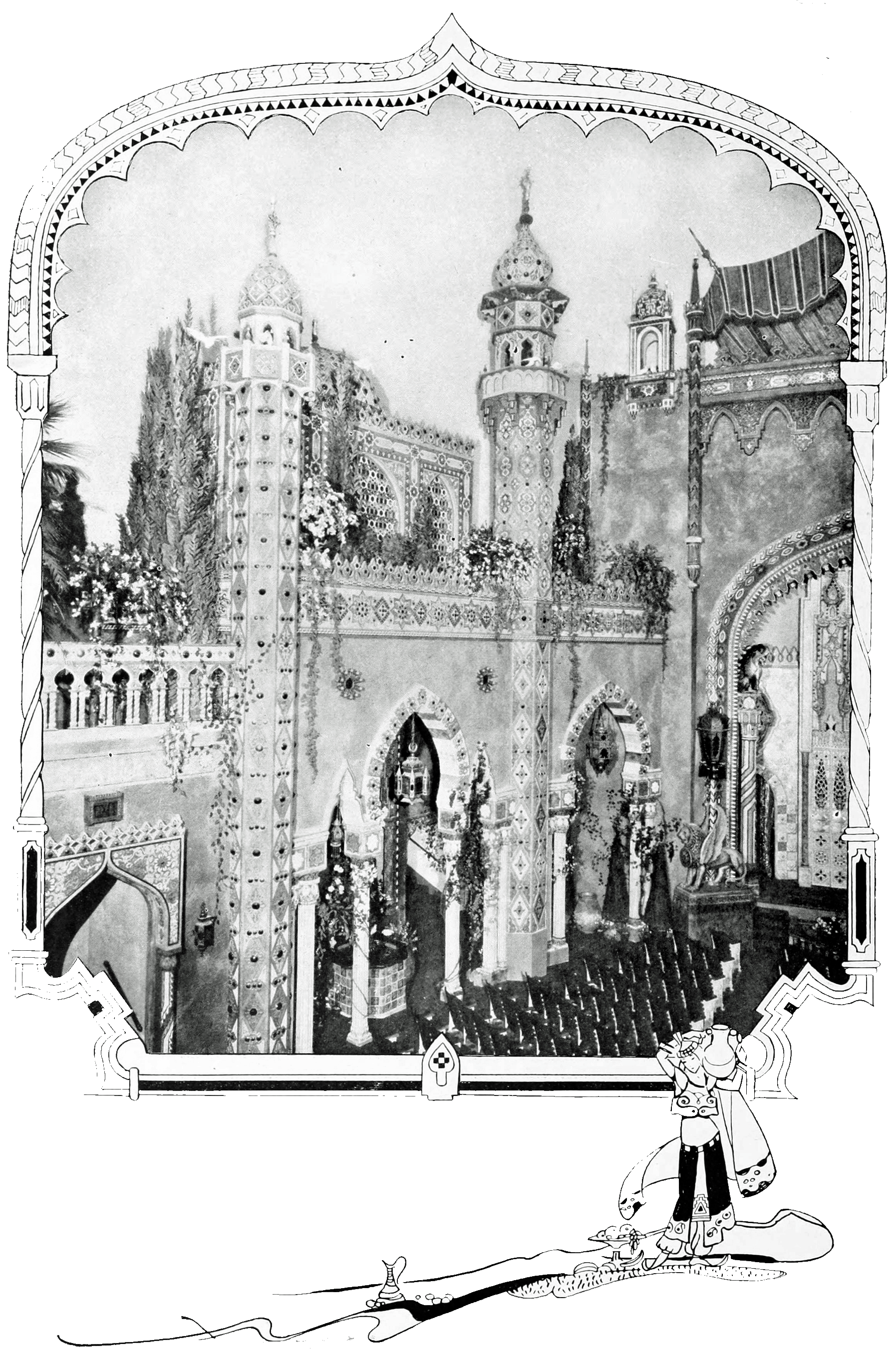
Avalon Theatre, Chicago
Detail of auditorium wall treatment of the Avalon Theatre, Chicago. Minarets and the bridal fountain are executed in special texture plaster inlaid with tile and foiled jewels, all back-lighted. A true replica of Persia.
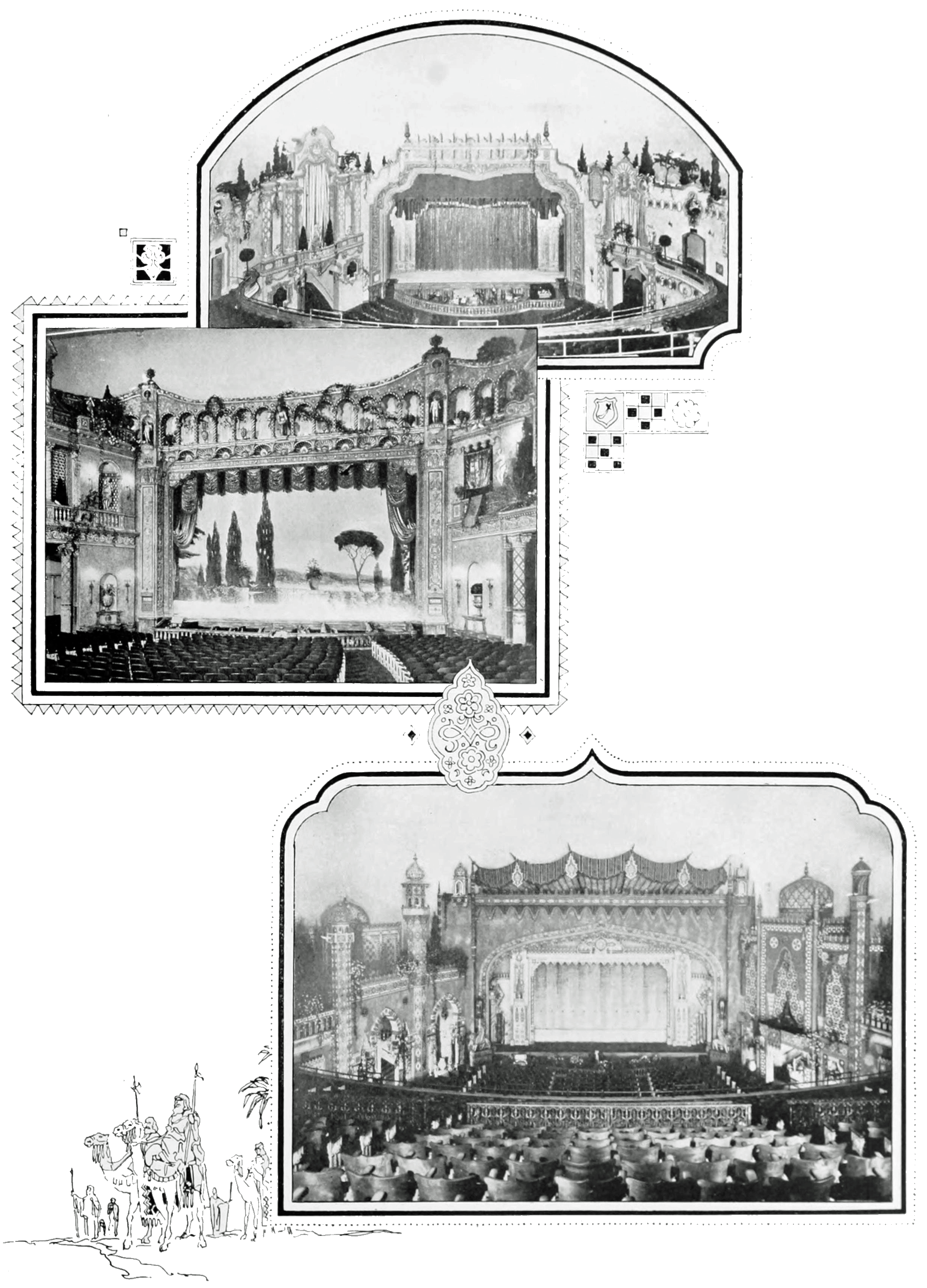
Auditoriums
Top: Young’s Theatre, Canton, Ohio, as viewed from the upper balcony. A sketch Spanish theatre in the style of Churriquera, which excells [sic] for its atmosphere of intimacy.
Middle: An Italian bridge surmounts the proscenium arch of the Universal Theatre in Brooklyn. A practical wide opening especially suited for the presentation of vaudeville and pictures.
Bottom: Proscenium treatment in the Persian style. A general view of the auditorium of the Avalon Theatre, Chicago. A colorful vista faithfully representing a shrine courtyard of Persia.

Foyers/Lobbies
Top: A view of the mezzanine promenade of the Olympia Theatre, Miami. Spanish atmosphere is achieved by Moorish Spanish tile spandrels in archways, rail embellished with antique Heraldic banners, and cloistered pendants for ceiling fixtures.
Middle: The foyer of the State Theatre, Kalamazoo. Northern Spain supplied the motives, carried out in the ornamental obelisk bracket fixtures on consoles, stately torchères, wall texturing and ceiling treatment.
Bottom: An interesting vista of the lobby, Riviera Theatre, Omaha, showing holdout rails and combination of faience and Ceramic tile floor. Note the concealed lighting.
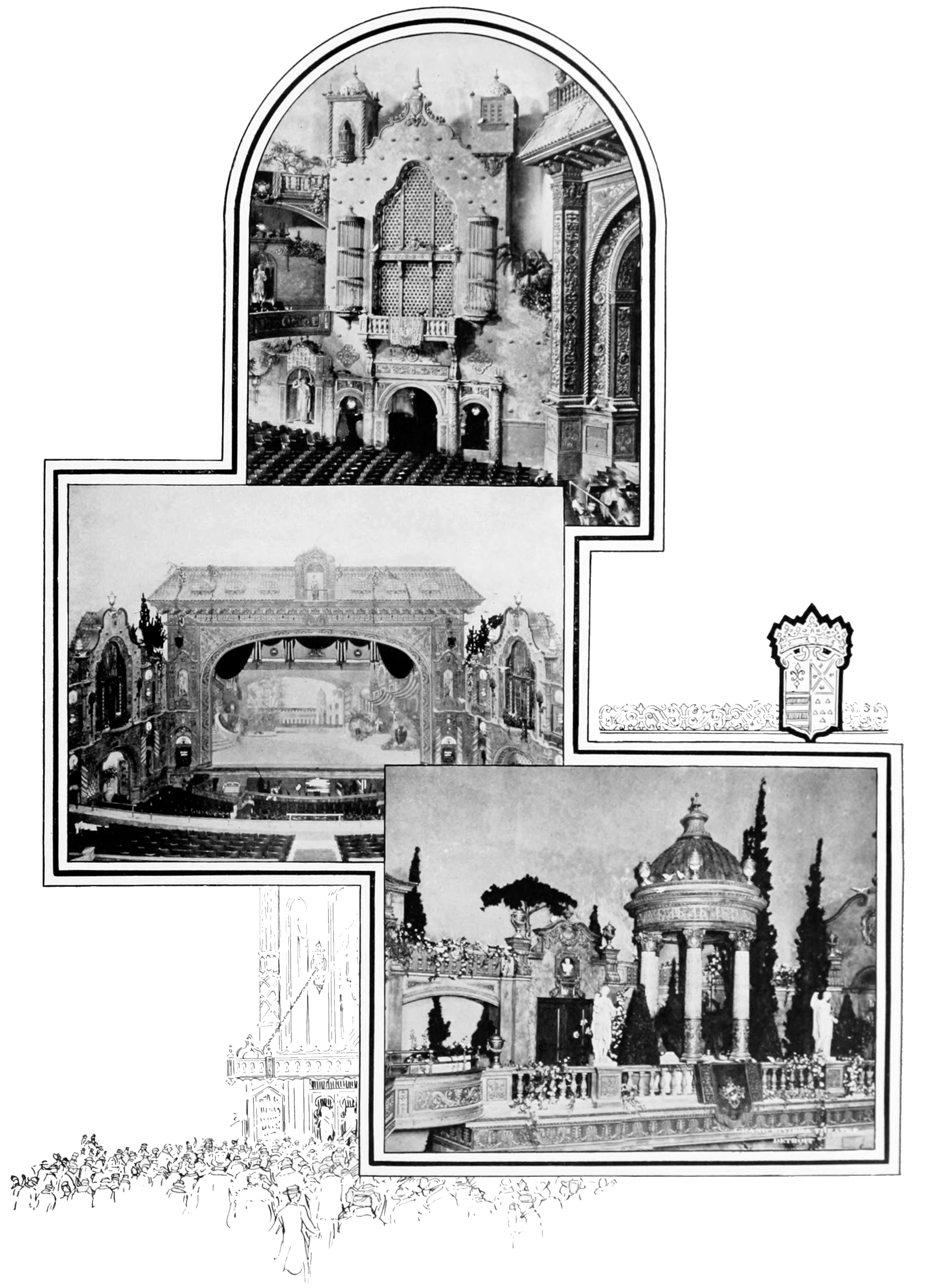
Auditorium Details
Top: Detail of the organ grille of the Olympia Theatre, Miami. It depicts the facade of an old Castillian castle, with minarets, iron window grilles and stone carved shell ornaments.
Middle: View of the proscenium arch of the State Theatre, Kalamazoo. It represents a gateway to a city.
Bottom: The Temple Court of the Riviera Theatre, Detroit. A representation of an Italian temple sheltering a weeded fountain, which forms the left-hand decoration.
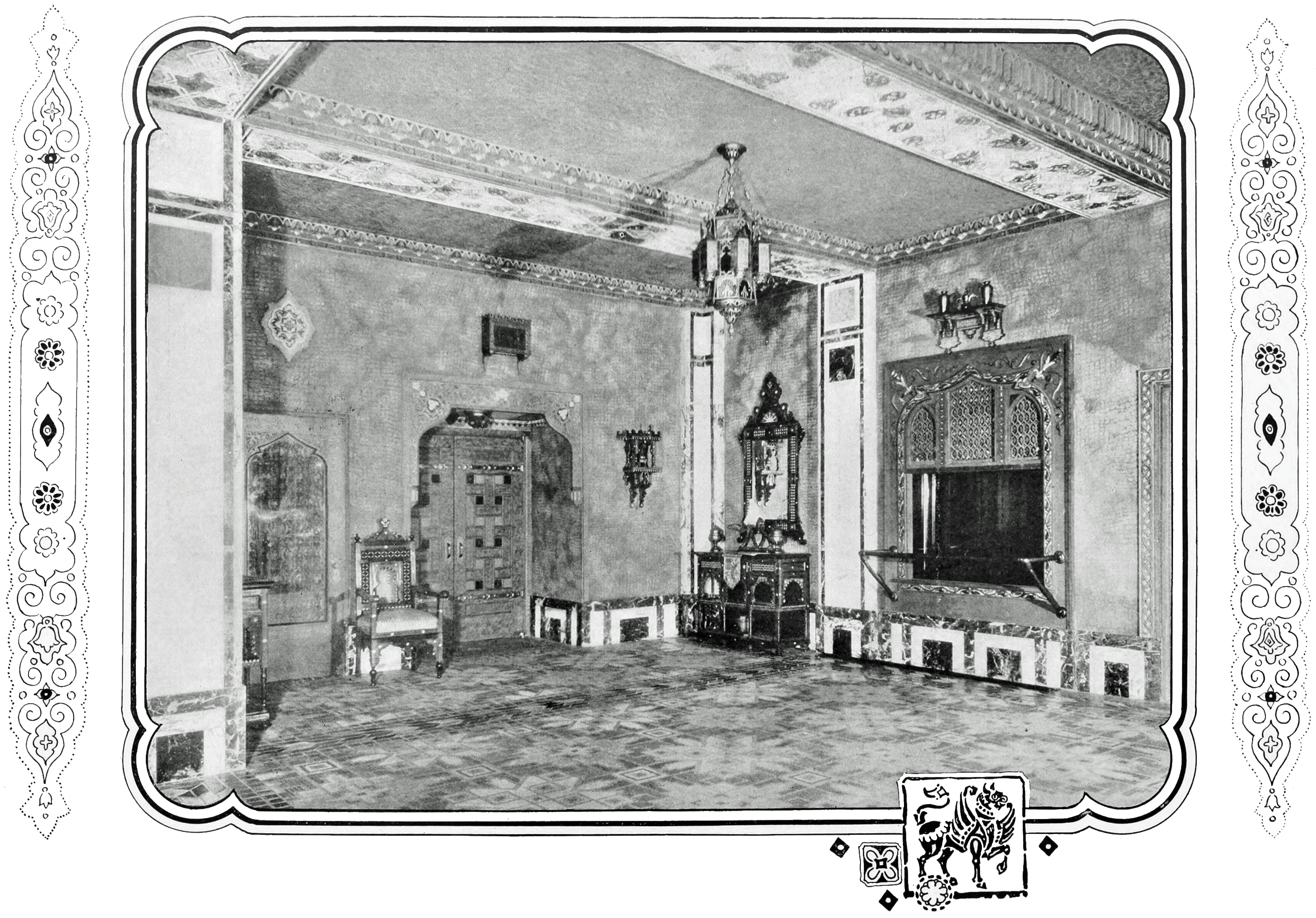
Avalon Theatre, Chicago
The aquarium and a nook in the Avalon Theatre, Chicago. A mirrored wall aquarium containing over 1,000 tropical fish in a glass tank planted with tropical plants forms one of the interesting attractions of this playhouse.
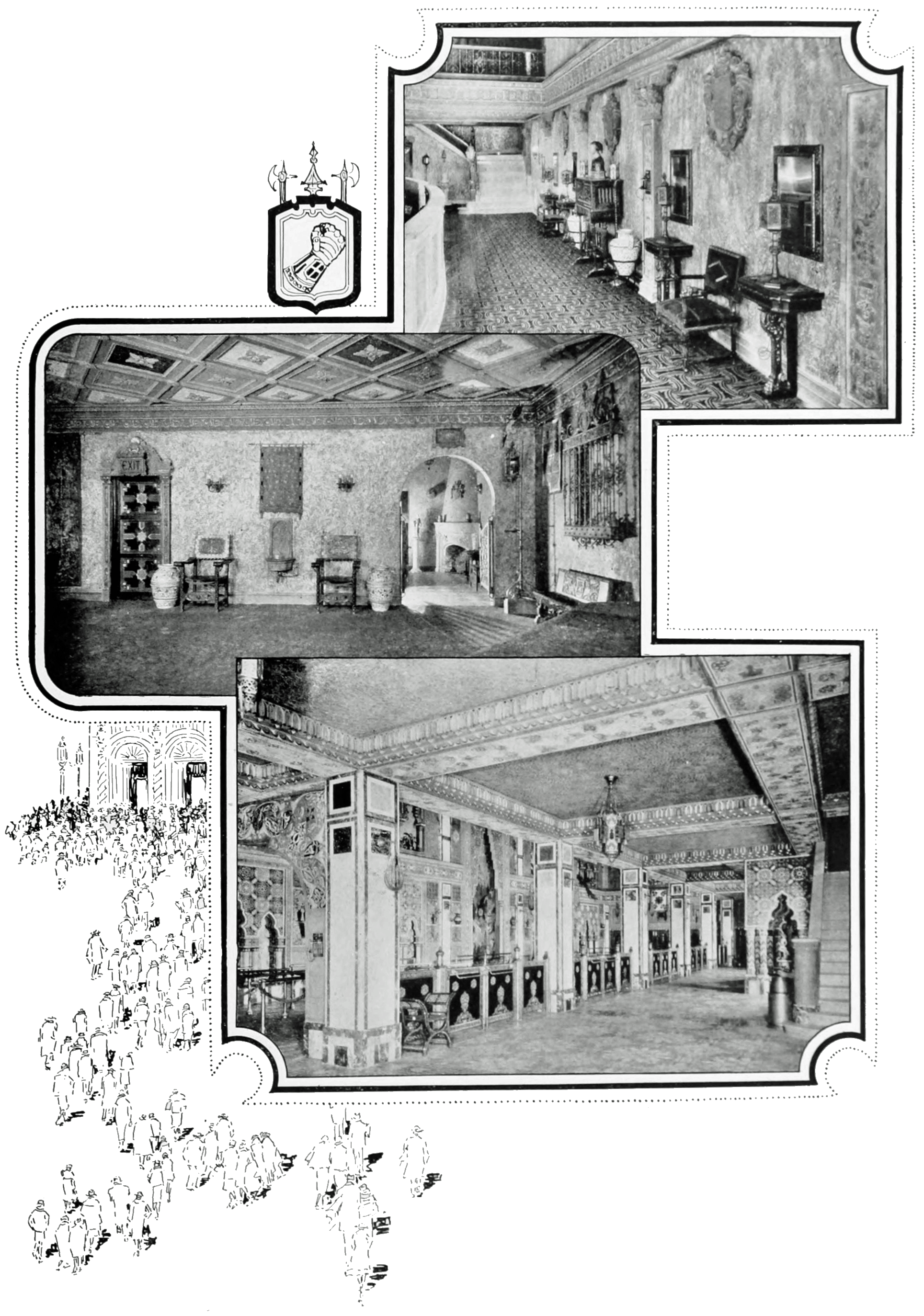
Foyer/Lobby Details
Top: A view of the foyer of the Tampa Theatre, Tampa. Original antique wood carvings with painted Heraldic shields, antiqued and polychromed wall pilasters are notable features of this atmospheric picture.
Middle: A glimpse of Loew’s Valencia, Baltimore. Polychrome Moorish paneled door, Hispano-Italian Jars; archway with carved gates opening into men’s smoker. The promenade is carpeted with a deep-piled carpet of soft variegated orange color. The walls are craftexed, finished in Spanish troweled fashion.
Bottom: The spillway of the Avalon Theatre foyer. Note the emergency gates executed in hand hammered brass with Padua velvet panels, and the multi-colored true Persian fashion finished marble columns. A genuine Persian temple lamp, executed in hammered brass, is suspended from the fore ceiling panel.

Young’s Theatre, Canton, Ohio
Photographic study of the upper sidewall of Young’s Theatre, in Canton, Ohio. Of special interest is the easy slope of the balcony seating and the pierced garden wall.
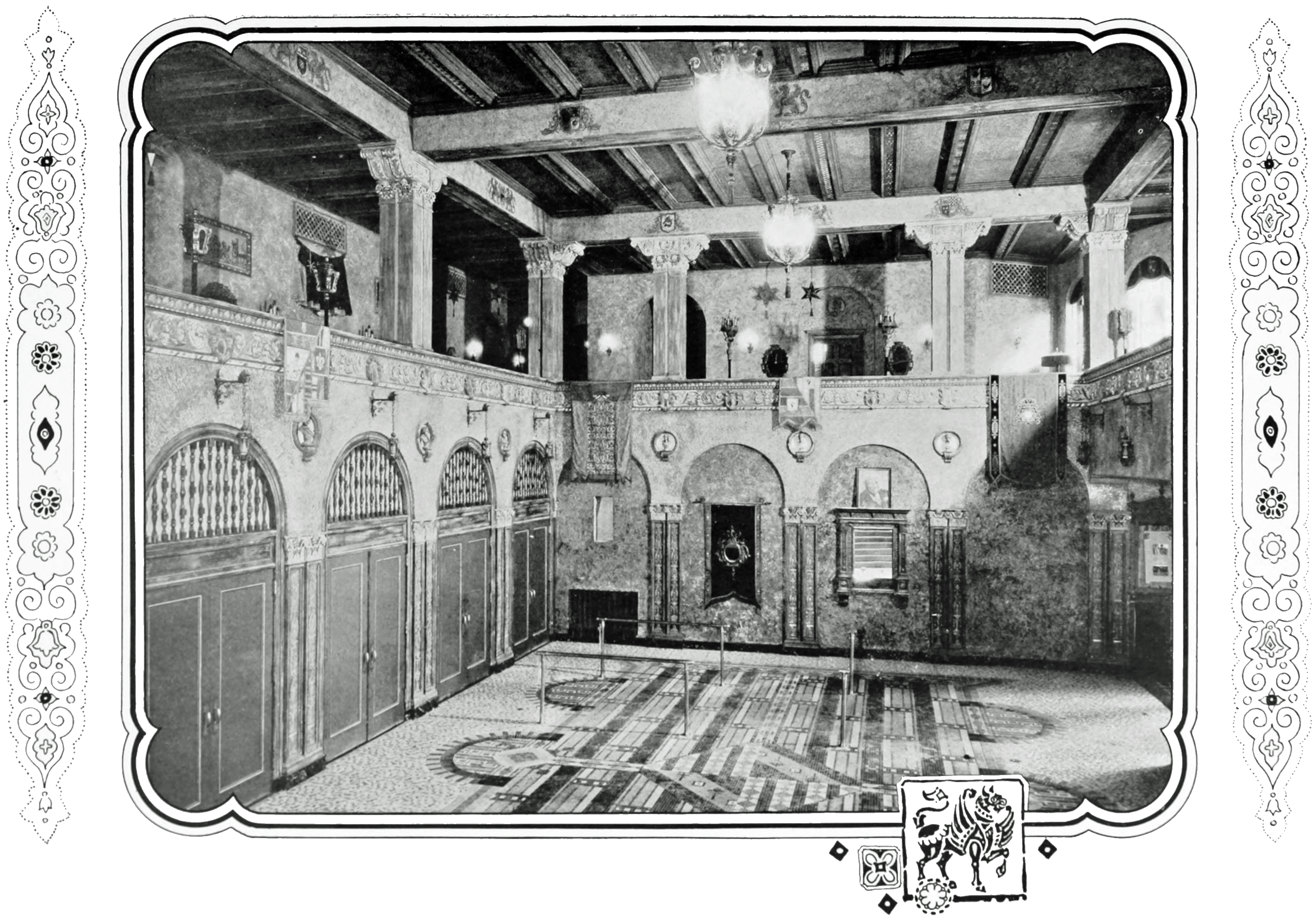
Universal Theatre, Brooklyn, N.Y.
Main foyer of the Universal Theatre, Brooklyn, N.Y., featuring an old cloister promenade, antique wooden beams and columns, old Italian Heraldic hangings and fixtures, a mosaic floor in Palermo fashion, and antique Strezzi lanterns.
Photographs copyright © 2002-2024 Mike Hume / Historic Theatre Photos unless otherwise noted.
Text copyright © 2017-2024 Mike Hume / Historic Theatre Photos.
For photograph licensing and/or re-use contact me here  .
.
| Follow Mike Hume’s Historic Theatre Photography: |  |
 |